Your Step-by-Step Guide to Creating Residential Rental Lease Agreements from a Template
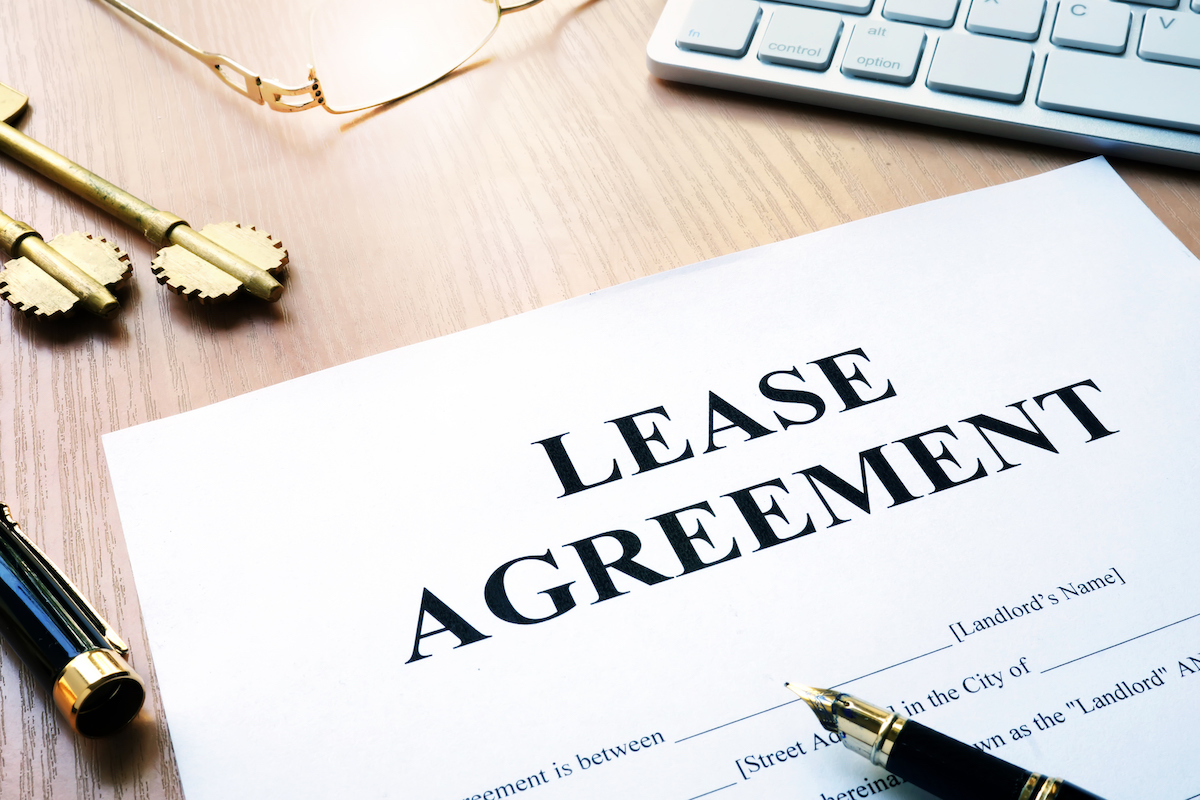
You need a Standard Lease Agreement. You also want to do it yourself, without paying a realtor or an attorney. Good, let’s do it!
In this article, I’m going to give you a Free Standard Rental Agreement, but more importantly I will teach you everything you need to know about Residential Leases, from downloading them, to completing them, to signing them with your new Tenant.
You see, there are plenty of Lease Forms floating around on the internet, but what good are they if you don’t know how to use them? As a lawyer and a landlord, I created from scratch what I think is the absolute best Residential Lease. I call it “The Landlord Guidance™ User-Friendly Residential Lease Agreement”.
I’m going to give you this lease for free as long as you promise to learn about using it. One more thing to get out of the way: In this article, I use the terms “Rental Agreement” and “Lease Agreement” interchangeably. I’m referring to the same document, so don’t get confused.
Scrolling below you’ll find (click to jump to Topic):
- How to Download the Free Lease
- Step by Step Instructions on filling it out
- How to Sign the Lease with your Tenant
- Frequently Asked Questions (FAQ’s) about Residential Leases
- A “Dumbed-Down” Explanation of All 67 Sections in the Lease
- Helpful Table Showing Security Deposit Limits, Landlord Access Notice Periods, and the Landlord-Tenant Laws for Each State
Ready for the fun part? It’s time to download your free lease agreement.
How to Download the Free Landlord Guidance™ User-Friendly Residential Lease Agreement
By the way, if you want to skip this Downloading and Filling Out part, and would rather have a form-builder “hold your hand” and “walk you through” filling out a lease, then Click Here To Create a Lease Using a Form Builder.
First, decide what file format you want to download your lease in. How computer savvy are you? If you know what a PDF File is, and know how to fill in a PDF using Adobe Reader, then PDF is for you.
If you have Microsoft WORD and prefer that popular program, then download it below using WORD.
If you’re old school (or just old) and don’t have a PDF Reader or Microsoft WORD, not to fear! Below you should try downloading and opening the lease in ODT Format or RTF Format. I bet that someway, somehow, your ancient dinosaur computer can open one of those files!
Simply Click on one of the file format image icons below to download the lease in that format. You might need to right click and “Save As” onto your computer.
Once you have the lease in your preferred file format, it’s time to fill it out. I’ll show you each step.
Step by Step Instructions on Filling Out the Residential Lease Agreement

Below I will show you how to fill out your lease. Because our PDF version is our most popular, I will show how to fill out that one. For the others just input the same information in those same places. Alright, on to the first section!
What Property Are You Leasing Out?
Full Property Address: Here you will want to put the address of the property that you will be renting out to the Tenant. This will almost always be the same as the mailing address. Do not forget the Unit Number or Apartment Number if you have one.
Property Legal Description: Most pieces of real estate also have a legal description that may include a County, City, Subdivision, Block and Lot Number. You can usually find it in the deed to the property, the property records, or on your local appraisal district’s website. Find your property description and put it in here.
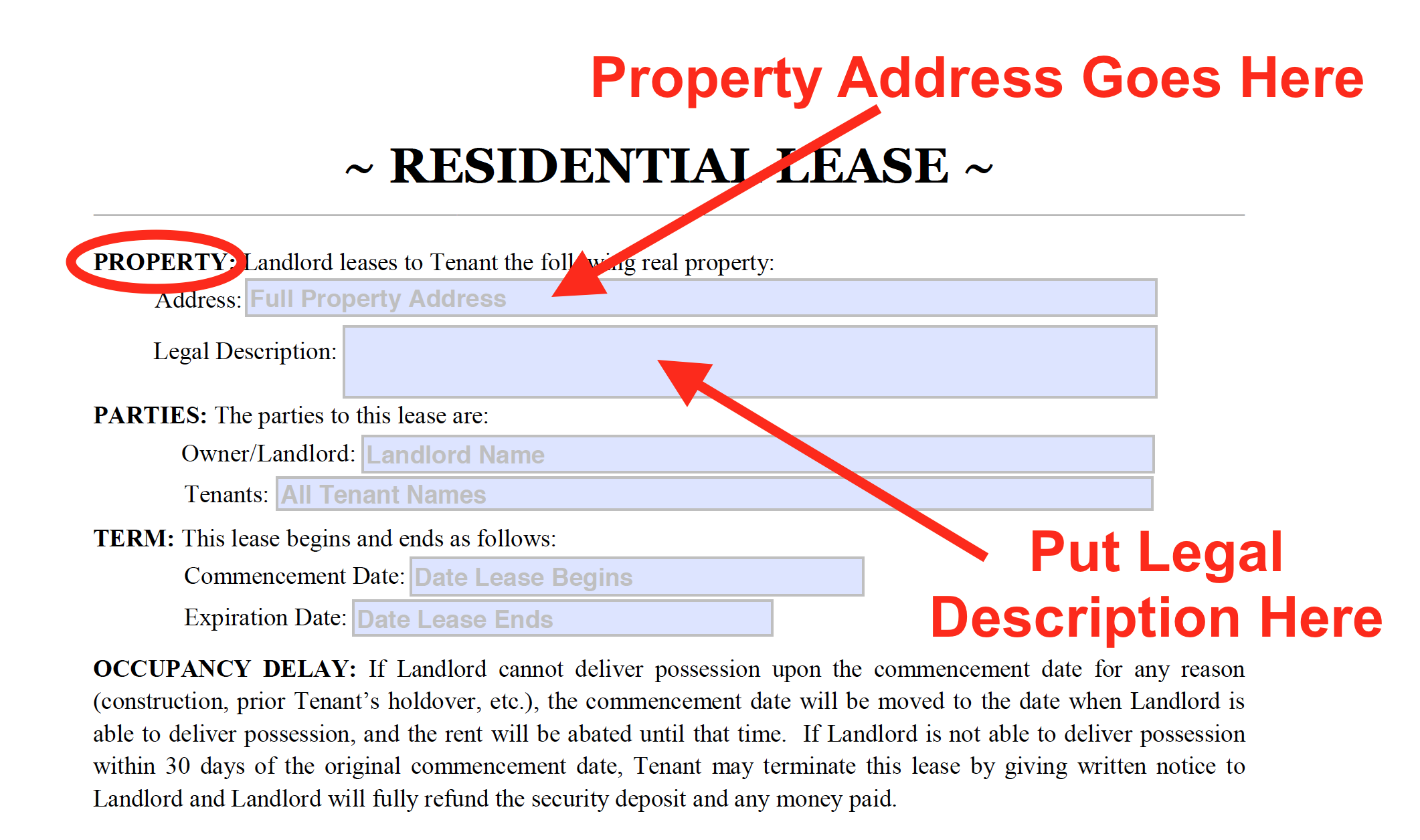
Parties to the Lease – Who is the Landlord and who are the Tenants?
Landlord Name: This is the owner of the property who is leasing it out to the renter or tenant. If you own the property in your name, then you are the landlord and you should put your name here. But if the property is owned by a Trust, Corporation, or LLC, then that Trust, Corporation, or LLC is the Landlord and you should put it’s name in the “Landlord” Spot.
Tenant Names: “Tenants” are the renters who will move into the property and pay rent to the Landlord. Put the first and last name of every adult Tenant (18 yrs and older) who is moving in. If you do not put the name of every adult, you are asking for problems later on. Imagine trying to evict someone from your house who is not on the lease, but you legally allowed to move in. It creates a mess. All these adult tenants will also need to sign the lease at the bottom.
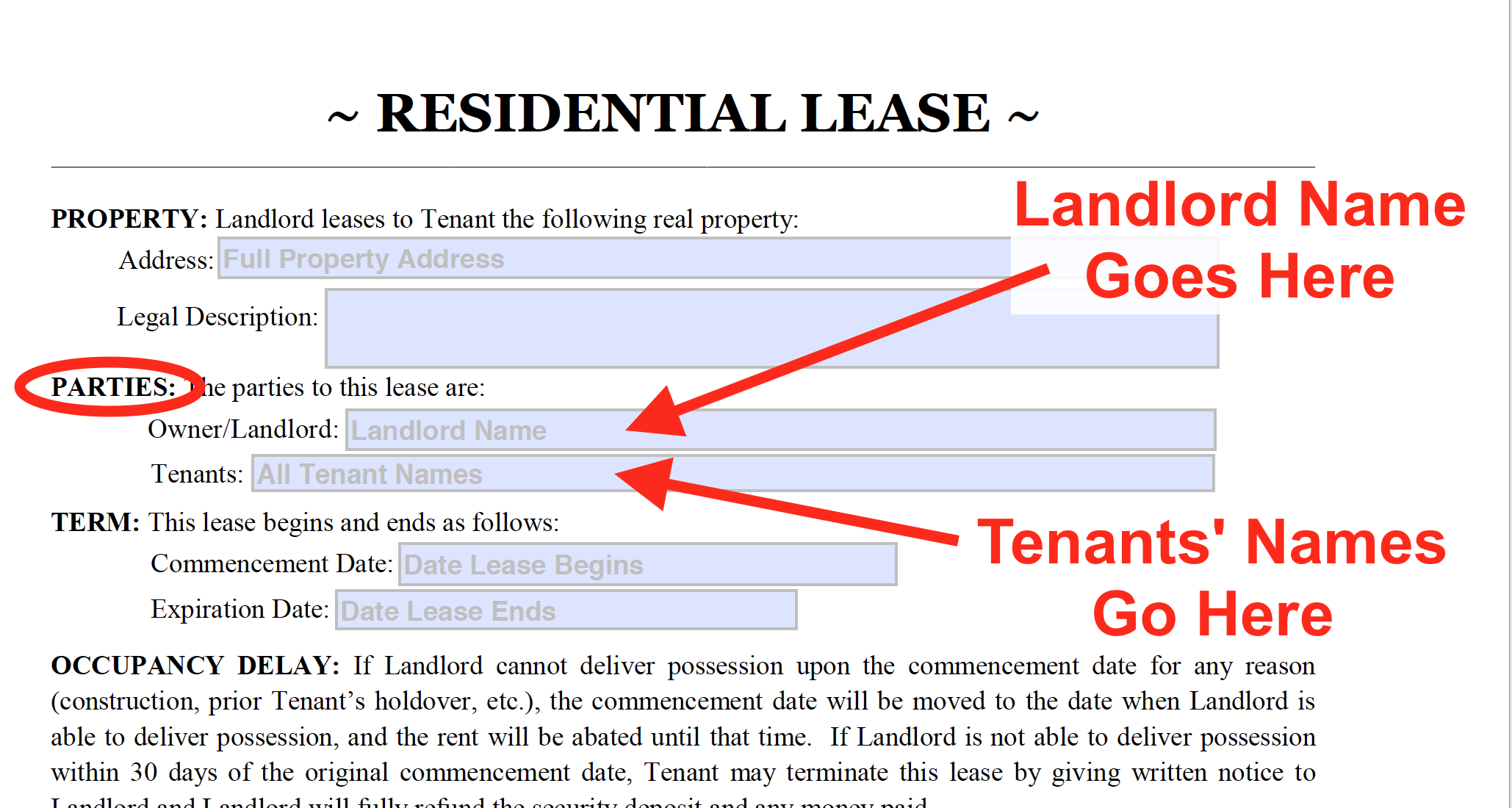
Lease Term – How long is this Lease?
Commencement Date: This is the day you want the lease to begin. It is usually the day that the Tenant will get the keys and be allowed to move in. Think about this carefully before deciding on a date. Make sure the Tenant will have time to switch the utilities into their name effective on the move in date. Otherwise they will be running the AC or heat for a full moving day with the doors wide open. That should not be on your tab. So go ahead and put here the day the Tenant moves in. It does not have to be on the 1st of the month. If it is in the middle of the month, you will simply charge them prorated rent for that partial month (explained below).
Expiration Date: This is the day you want the lease to end. It is best to make it end on the last day of a month, for simplicity purposes. A typical residential lease term is 1 year, so the lease expiration would be 12 months from the Commencement Date, or 12 months from the beginning of the first full month. As an example, if a lease starts on December 15th, 2020, then the first full month of the lease would start January 1st, 2021 and then the 1 year lease term would end on Dec 31st, 2021. If you are only doing a six month lease, then put in the end of the sixth month. For example, if your 6-month lease Commences February 1st, then the Expiration Date would be July 31st (a full six months). So do your calendar math and put in your lease expiration date.
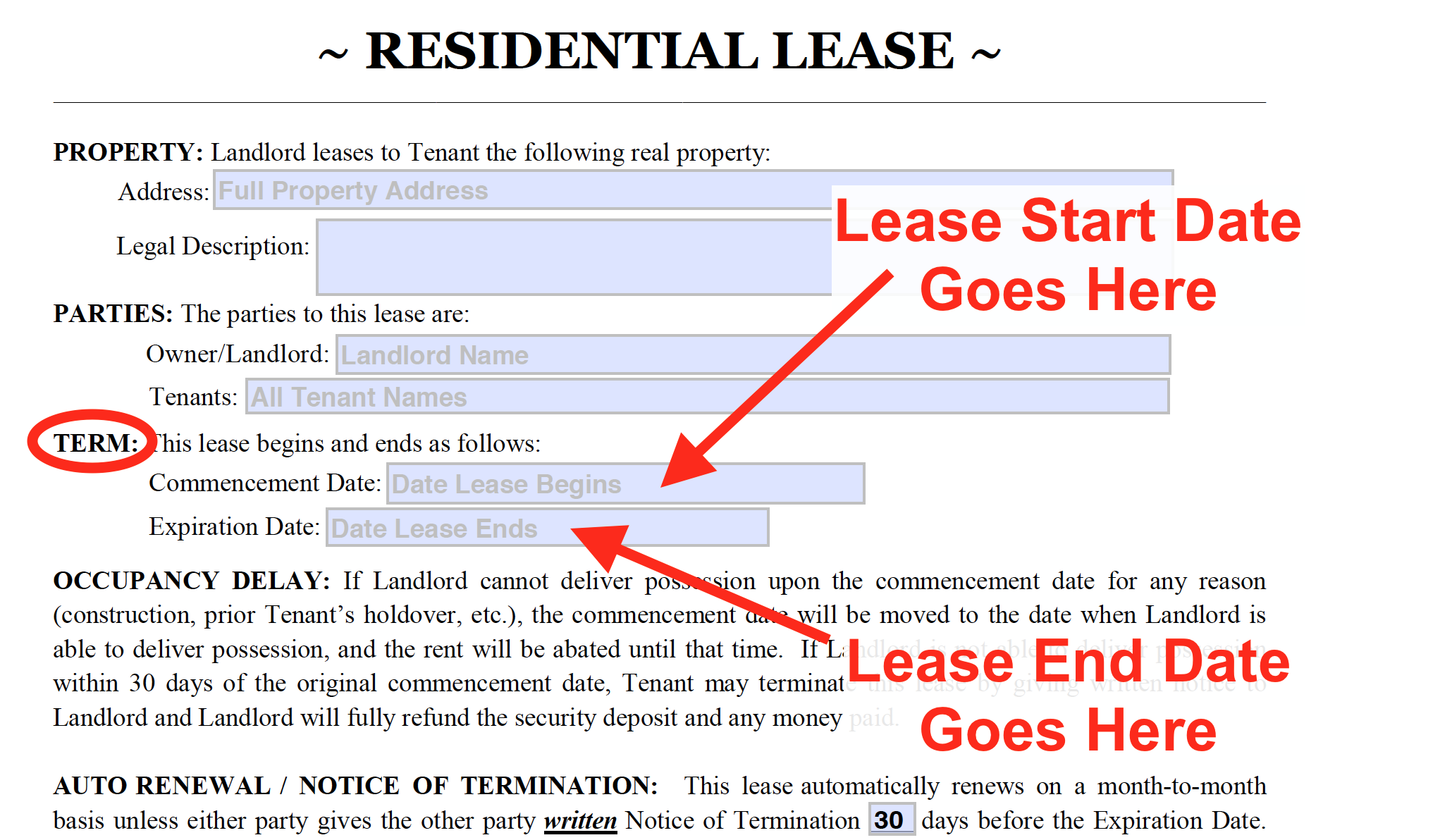
Auto Renewal and Notice of Termination
This section explains that the lease will automatically renew on a month-to-month basis unless either party tells the other party that they want to move out or sign a new lease. The key here, and what you need to do, is input how many days notice (how many days in advance) either party must tell the other party what they want to do (ending at the expiration and ending the month-to-month scenario).
How does it become a month-to-month? For example, the lease gets going, the Tenant is paying rent every month, the lease expiration date passes by, the Tenant keeps paying rent, and the Landlord keeps accepting it, then the lease has then turned into a month-to-month lease agreement. But let’s say the Landlord wants to raise the rent at some point. Then the landlord needs to give 30 days notice (or whatever amount of days you put) that the lease will terminate unless the Tenant signs a new one with them.
So what to put in this section? Almost everyone puts 30 Days into both boxes in this section, but go ahead and put what you want. But if you put less than 30 days, make sure it complies with your state’s landlord-tenant laws.
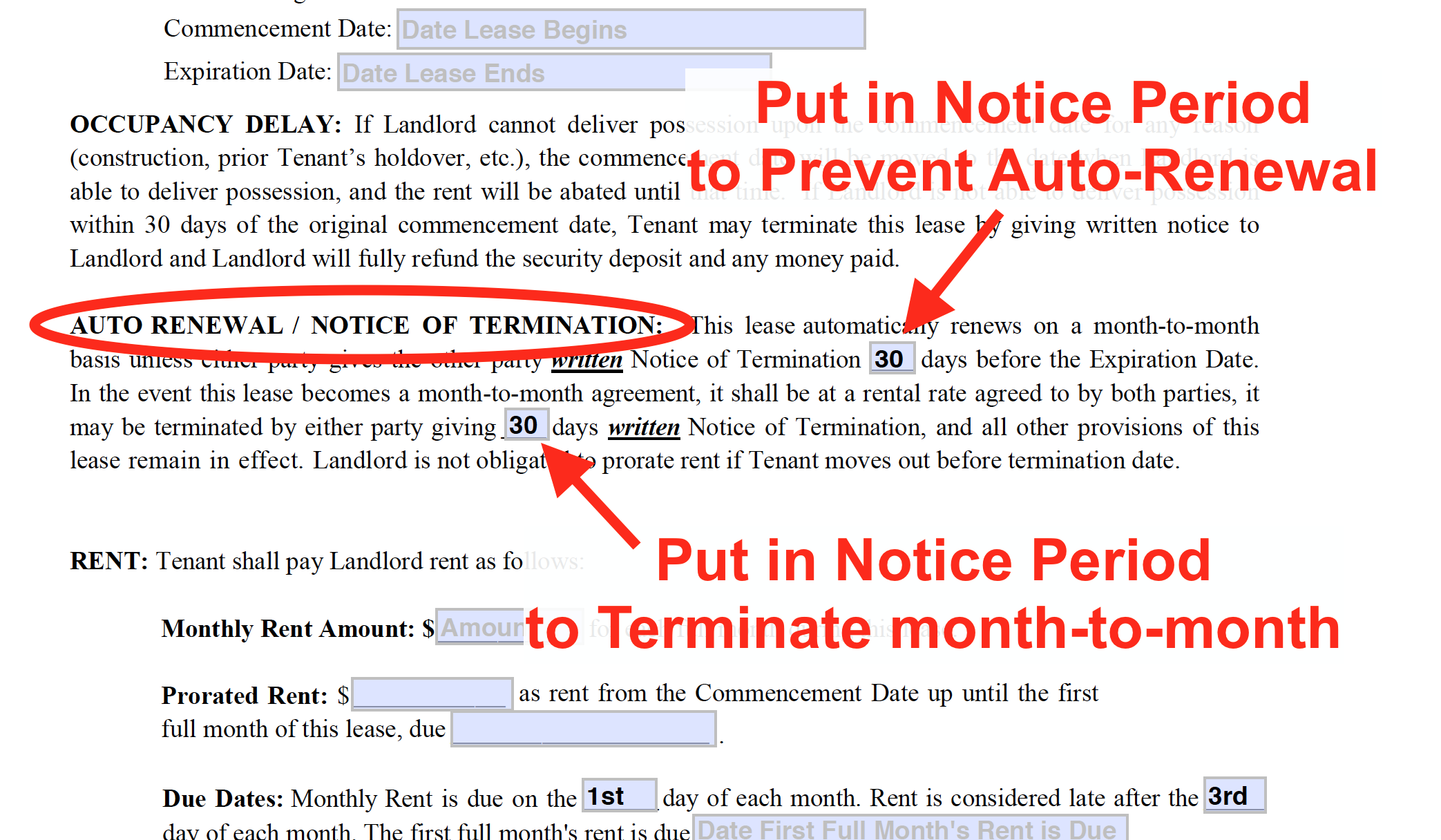
Rent Amount, Due Date, and Rent Payment Methods
Rent Amount: This is the amount of monthly rent you want to charge your Tenant. So how should you figure that out? I like to go to Zillow and see what other similar homes in the area are going for. So once you decide, put the amount in here (of course your prospective tenant needs to agree to it).
Prorated Rent: Remember above I explained that if the lease starts in the middle of the month, then you will charge “pro-rated” rent? Well this is where you put that amount. Prorated Rent is simply charging them rent for a partial month at the beginning of the lease. Let’s look at an example to see how to calculate it.
Lets say that you will be charging a monthly rent of $1500 per month. And your Tenant will be moving in on March 22nd. That means they need to pay you rent for the 22nd thru the 31st (10 full days). So let’s first figure out the daily rent. Take the monthly rent ($1500) and divide by the number of days in March (31), and you get daily rent of $48.38. Now multiply that by the 10 days the Tenant will be staying during that pro-rated time, and you get $483.80. So you would put that amount in the first box next to “Prorated Rent”.
The Prorated Rent Due Date is when the Tenant must pay the prorated rent. I recommend that the prorated rent be paid when the lease is signed, since it covers a time when they will be starting to live there. If the prorated period is 15 days or less, I would recommend collecting the Prorated Rent AND First Month’s Rent at the lease signing, along with the Security Deposit. And as a side note, do not take personal check for these things. I got burned bad once that way. Make sure it’s Cash or Certified Funds.
Due Dates: Unless some unusual situation, the Due Date for the monthly rent should be the 1st of each month. In most states you can “consider it late” after the 3rd (2nd box), but please check your state laws to be sure. As for the box asking for when the “First Full Month’s Rent is Due,” this will also usually be the 1st of the month, unless otherwise agreed to.
Payment Methods: This is how you will let the Tenant pay you the rent. Before you get excited and simply check every box, thing long and hard about this one. Is it safe having a Tenant bring you or drop off large amounts of cash? What if they say they dropped off the cash but they didn’t? What if they know what drawer you stuff it in and somehow it gets stolen?
On the other hand, are you going to let them pay with personal checks that might bounce? Are you going to let them pay with PayPal or a Credit Card, upon which they could contest the charge at a later date?
You might want to limit them to Cashier’s Checks and Money Orders.
Want to know what I do? I require Cashier’s Check, Money Order, or Cash or the First Month’s Rent, any Prorated Rent, and the Security Deposit. Then after that I allow personal checks, Cashier’s Check, Money Order, and sometimes cash (but don’t prefer it). I do not allow electronic methods.
A lot of this also depends on how you run your Landlord business. If your Tenant is an old lady living upstairs, it’s probably fine to accept cash (unless she’s one of those dangerous old ladies). So give it a think and check the boxes that you will allow.
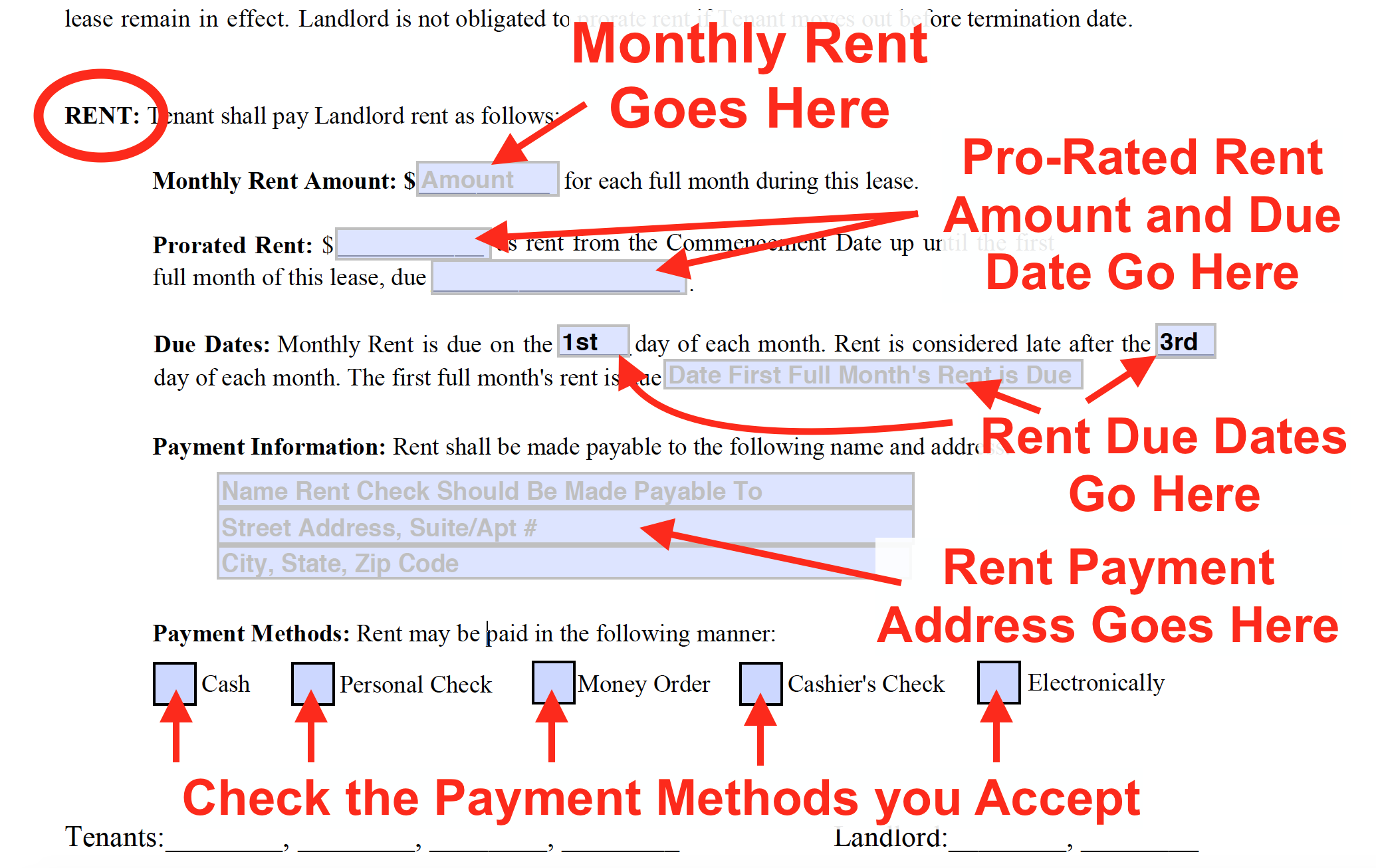
Late Fees that You Will Charge
Why charge late fees? The real reason in to incentivize your Tenant to pay on time. It usually works. But if they do pay late, they will pay a penalty, which further incentivizes them to pay on time the next month. It also puts a little more cash in your pocket to compensate you for waiting. Think of it like interest on a loan. Tip: Always charge the Tenant the late fee if they are paying late. Why? Because if you don’t they are likely pay late every time, taking advantage of your interest-free credit you’re extending them! So here’s how to fill out this section:
Date the Late Fee will Apply: The number in this box should match the day in the Rent Section above. Usually it is the end of the 3rd day of the month when the late fee will apply.
Initial Late Fee: This is the late fee that is triggered when you don’t receive the rent by the end of the 3rd day (or the day you put in the box above). I usually put $25, but put whatever you think is appropriate, and make sure you’re complying with you state and local rules.
Per Day Late Fee: After the initial late fee, the fees keep racking up day after day. Why? Because if the late fee was just $25, the Tenant might deem that an acceptable fee to wait until the 20th of the month to pay you. And no, “Homey don’t play that.” So we add an extra daily amount for each additional day the rent is late. I personally do $10 per day extra. So if the Tenant pays 3 days after the 3rd, the fee is $45 ($25 + $10 + $10). Some tenants pay a little late every time, and are okay paying these extra fees. That is extra rent money for the Landlord.
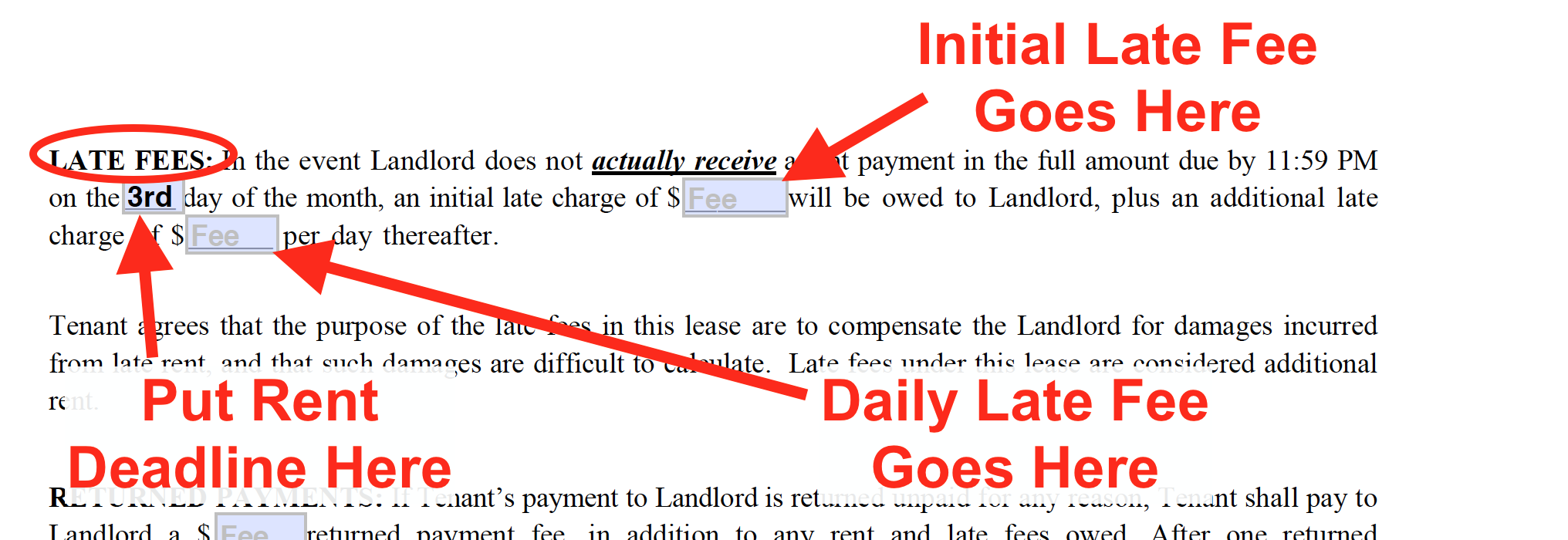
Returned Payments such as Bounced Checks
Ever had someone bounce a check on you? It’s pretty infuriating, especially if it causes your account to go in the negative. Your bank charges you a “bounced check fee.” And it also means the rent is probably now late. Therefore you’ve got to charge a “Returned Payment Fee”. So put in this box the amount you will change. The amount needs to cover what your bank will charge you for bouncing the check, as well as compensate you for the headache.
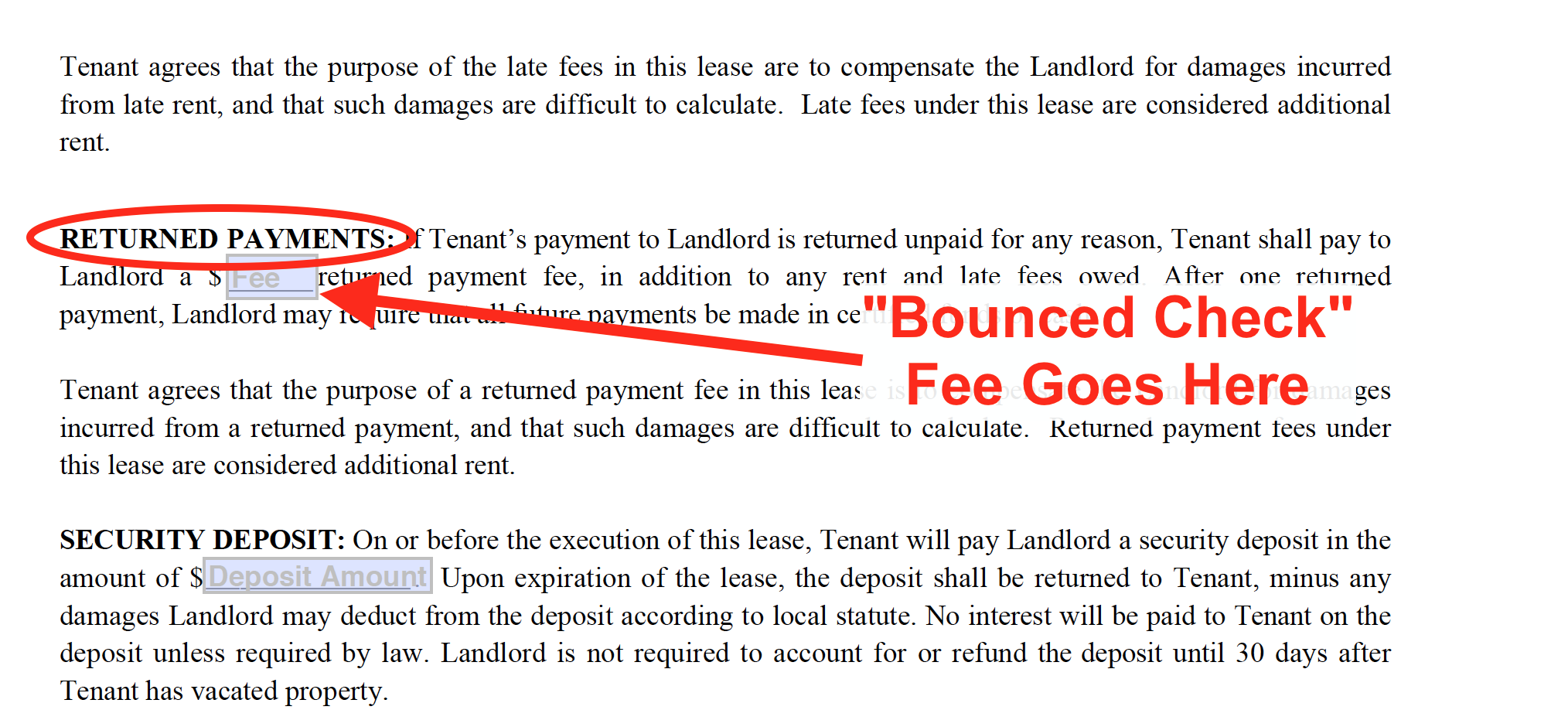
Security Deposit Amount
The purpose of the Security Deposit is so that the Landlord has money in reserve, up front, to pay for any damage that the tenant does (beyond normal wear and tear) during the duration of the lease. At the end of the lease when the Tenant moves out, the Landlord may deduct money from the Deposit for damage, and then must return the remainder. Any deduction must usually be in writing, and given to the Tenant (along with the remainder amount) within 30 days. Check your local rules on this one too.
Amount of Security Deposit to Charge: Some states regulate the amount you can charge. Look up your state in the chart below. I usually charge a Security Deposit equal to one month’s rent. So if the rent is $1,500, then I also charge a $1,500 Deposit. But if you have reason to believe the tenant might do damage (perhaps after you called their references on their Rental Application), then charge more if your jurisdiction allows. So in this box, input the amount you will charge.
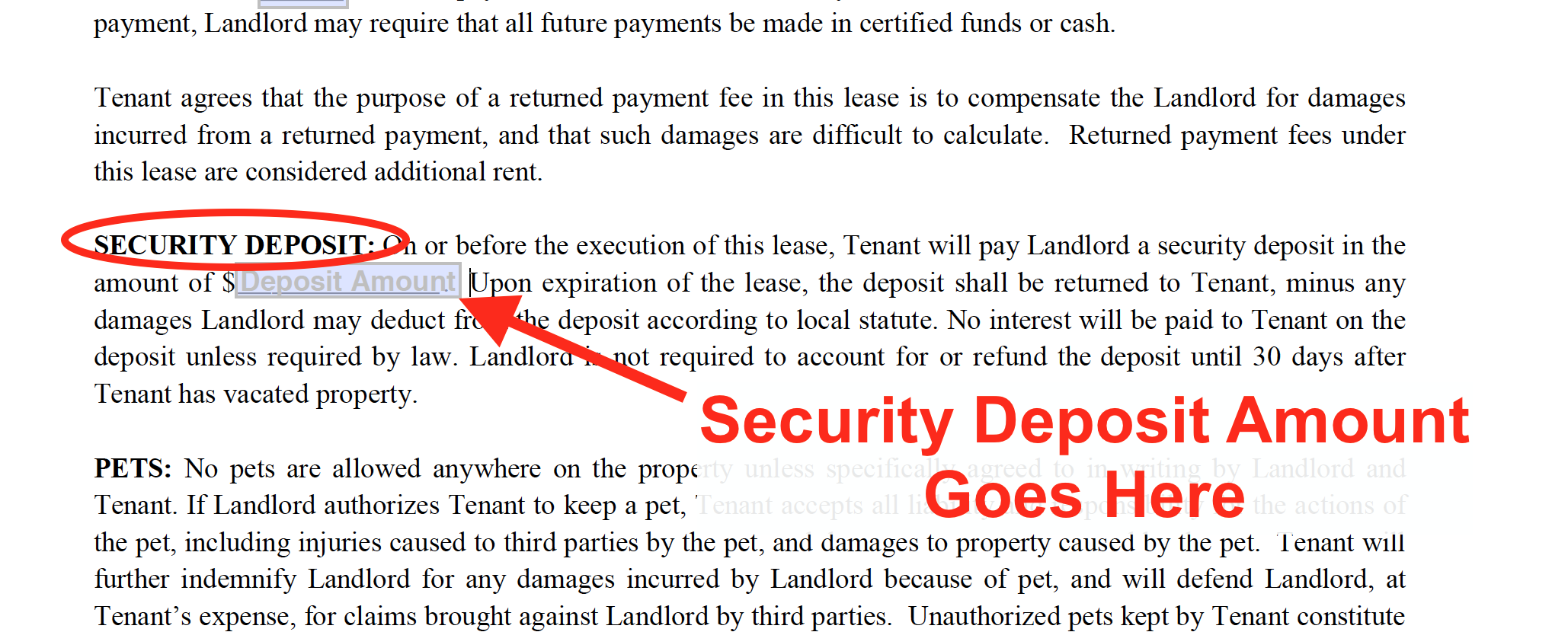
Pets in your Rental Property
This one is up to you, the Landlord. But here’s what you need to know. People like their pets, and accepting pets will open up your property to more prospective tenants. But pets, especially large dogs, or a large quantity of kitty cats (think crazy cat lady), can totally destroy your property. Not just tearing up walls and carpet, but soaking urine deep into the floors and foundation. It can get really bad. Therefore, proceed with caution.
So YES or NO to Pets?: Click the “No Pets…” circle if you are not allowing pets. And click the circle below that if you are allowing pets. If you indeed are allowing them, put in the number you will allow (i.e. 1 or 2), and describe the pet the tenant has (i.e. White Poodle). You should probably not allow dangerous animals, like certain dog breeds or wild animals. Also, do not allow a whole bunch of pets. Trust me. They will ruin your rental property (which is your investment).
Non-Refundable Pet Deposit: If you are allowing pets, charge a “non-refundable” pet deposit. This means the money is yours as soon as you receive it. Why “non-refundable”? Because we all know that almost any pet will cause some damage. If the pet is a large dog, you might want to charge $350. If it is a little hamster, maybe $30 will do. So put in the amount you will charge in this box.
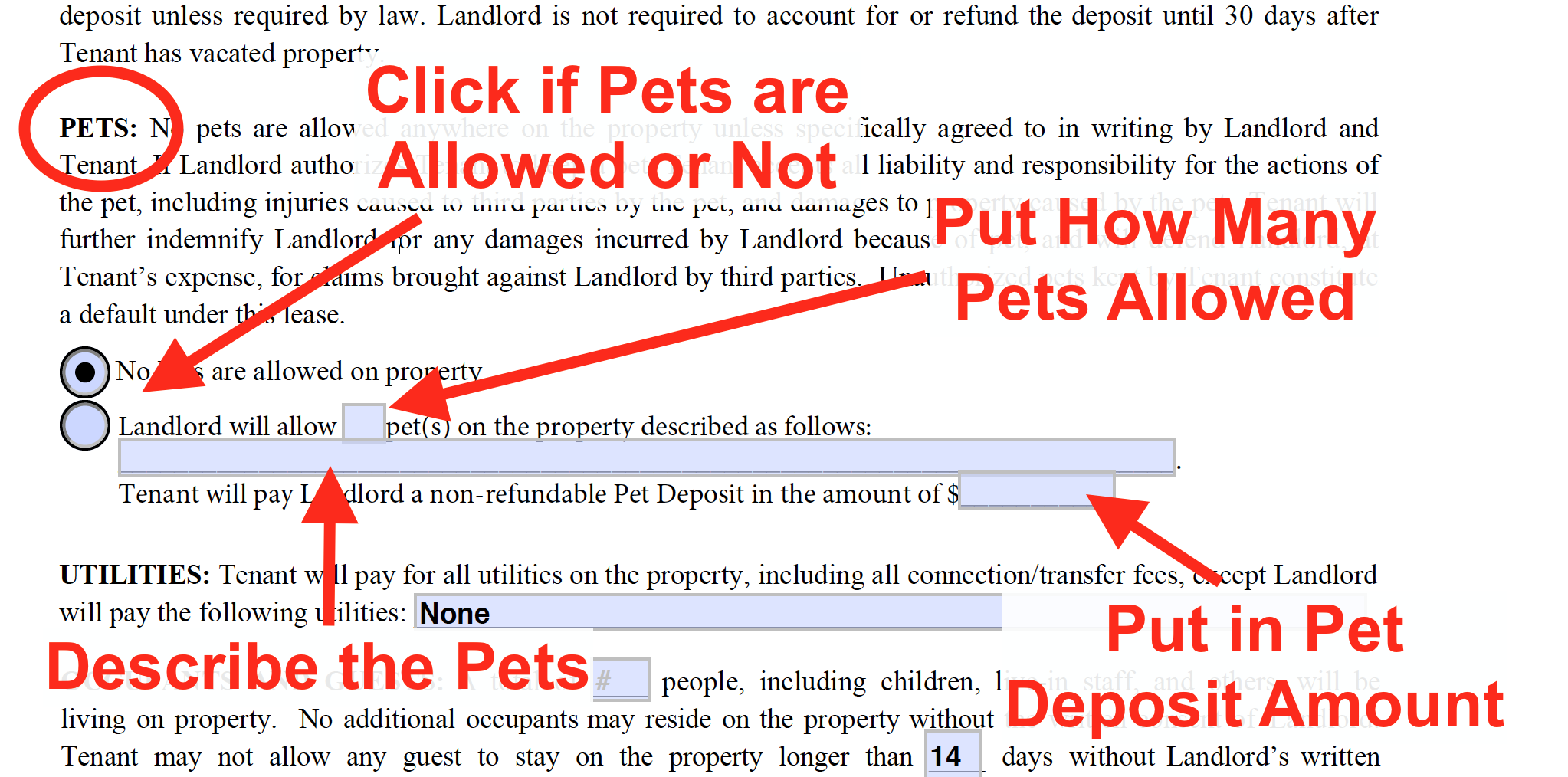
Who Pays the Utilities?
It’s usually not a good idea for the Landlord to pay for the utilities. Why? Because when someone else is paying, the usage goes way up. Why not run the AC all day and take long showers? Someone else is paying. It is best (and common practice) to have the tenant pay all the utilities. However sometimes there are certain utilities that the Landlord does pay. If this is the case for you, replace the word “none” in this box with the name of the utilities that you will pay.
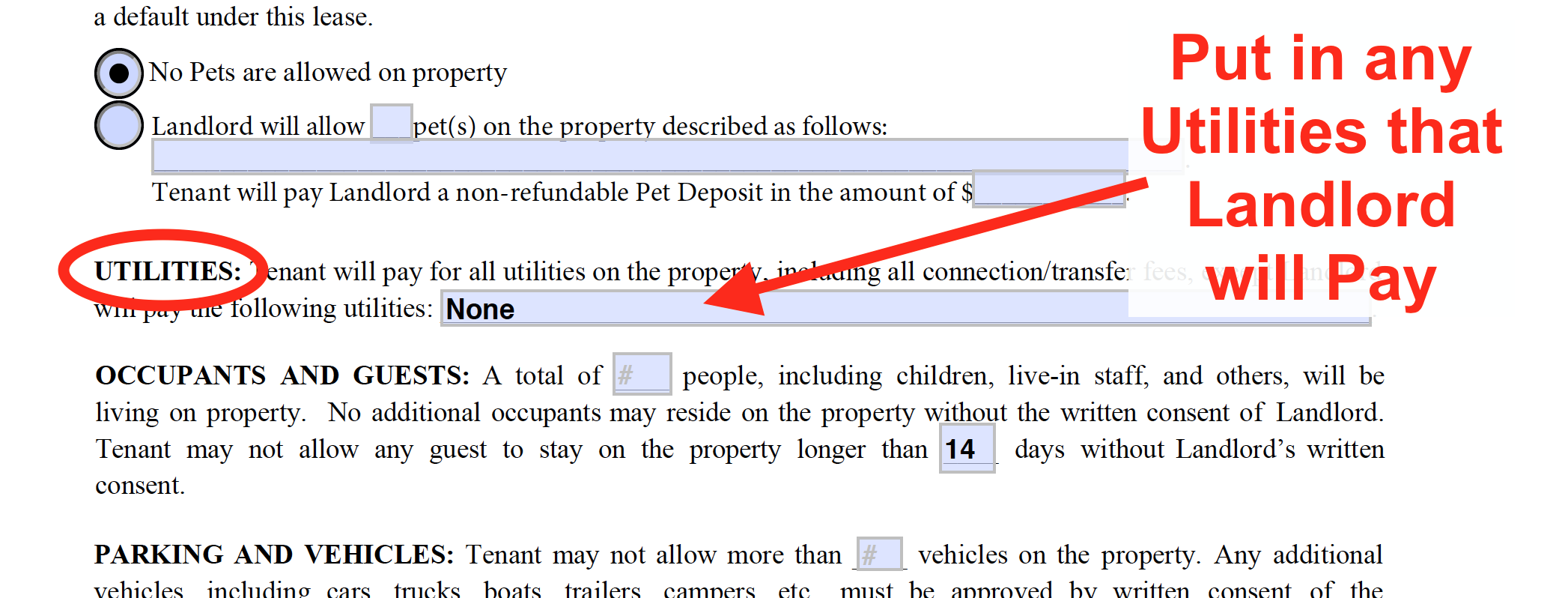
Occupants and Guests – Who is allowed in the Property?
It is important to specify how many people are allowed to live in the property. Otherwise, cousins and friends may move in, and then too many people will be living there (more than the property was intended for). This will wear down the place pretty quickly.
Occupants Living in the Property: So in this first box, put in how many people are allowed to live there (usually just the tenant and their immediate family – they should have already told you this on their Rental Application).
Guests: We also don’t want a tenant to have their beer-drinking buddy move in, and argue that, “oh, he’s just a guest”. So we put a cap on how long a guest can stay. 14 days is usually long enough. I know that I don’t have guests stay that long. But I do have some friends that have their parents from out of the country come stay for 2 months! So in this case, the lease says that the tenant can get prior consent in writing from the landlord (and you can decide “Yes” or “No”).
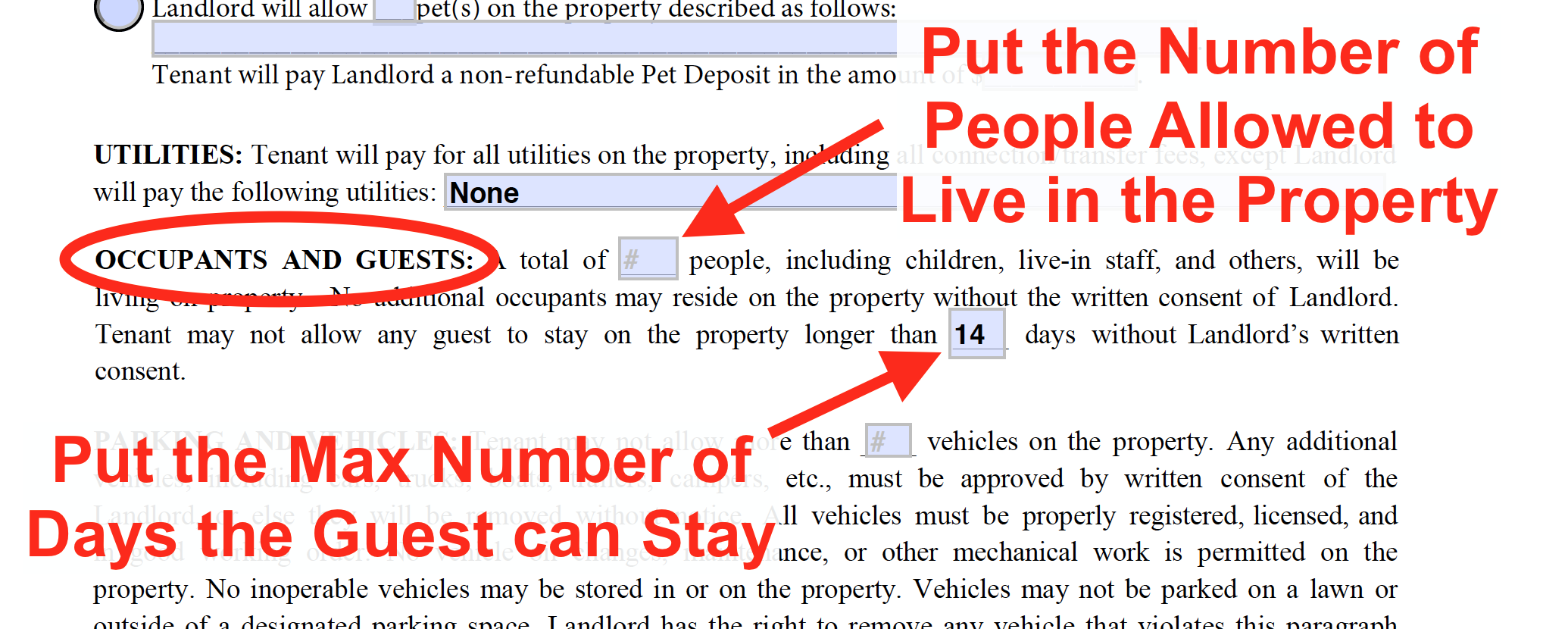
Parking and Vehicles
For some reason, it seems that Tenants like to accumulate vehicles and work on them at, or in, the properties they rent. I once heard a speaker at a landlord convention talk about his tenant who he caught taking apart a motorcycle inside a bedroom. And we have all seen the house with 3 cars up on blocks in the driveway, and the just sit there and get older. So for these reasons, as Landlords we cap the number of vehicles a Tenant can have, and we also have rules about those vehicles (they must be licensed, operable, etc.). So in this section, simply put in the number of vehicles the tenant may have.
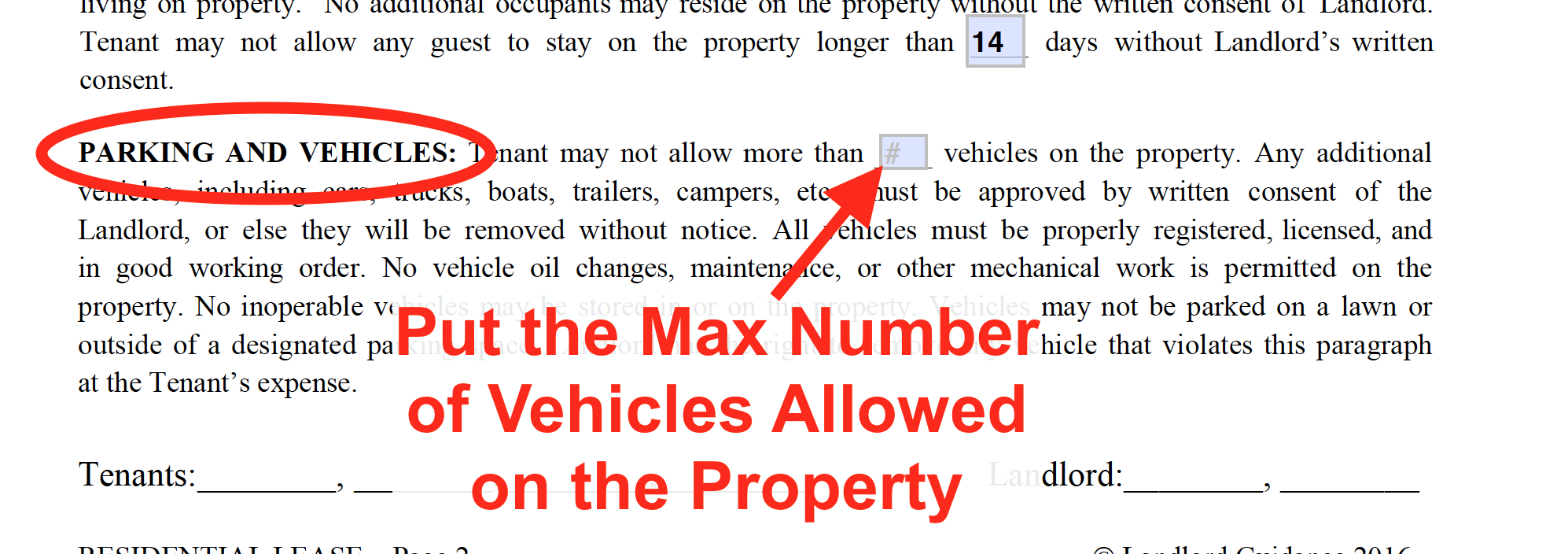
Will you allow Smoking on the Property?
Smoking inside a home will definitely make the walls yellow and add a smoke smell. I always say smoking “is not” allowed in my properties, but for you it might be different. It depends the home, the area, the relationship with the tenant, etc. If the Tenant seems good, but they smoke, you can always put in the Special Provisions section of the lease that smoking is only allowed outside on the porch or patio, but not inside the home. So in this paragraph of the lease, go ahead and click whether smoking “is” or “is not” allowed.
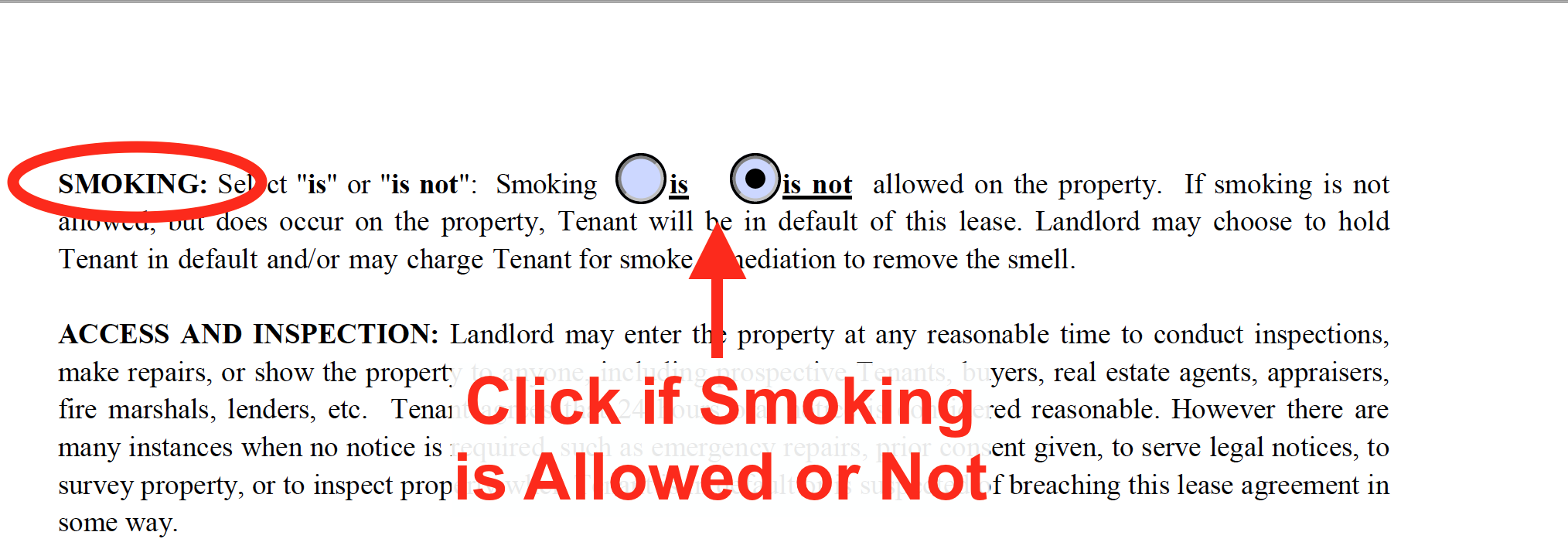
Landlord Trip Charges
Let’s say that you and the Tenant agree that on Monday morning at 10:00 AM you will come by to inspect the property. You show up at 10:00 and the Tenant is not there to let you in. Although you have a key, the Tenant has a dog that you’d prefer to not deal with. You will have to come back another time. The Tenant has wasted your time and caused you to make an unnecessary trip to the property. In this case, you can charge them a “Trip Charge.” Make it large enough to cover your time and expense, and enough to incentive the Tenant keep their commitments. But if it’s too large, a judge may not uphold it (if it came to that point). Also consider how close you are to your rental property. If you a 1 minute away, then a $100 trip charge is probably excessive. I personally put $30. You should fill in what you will charge in that situation.
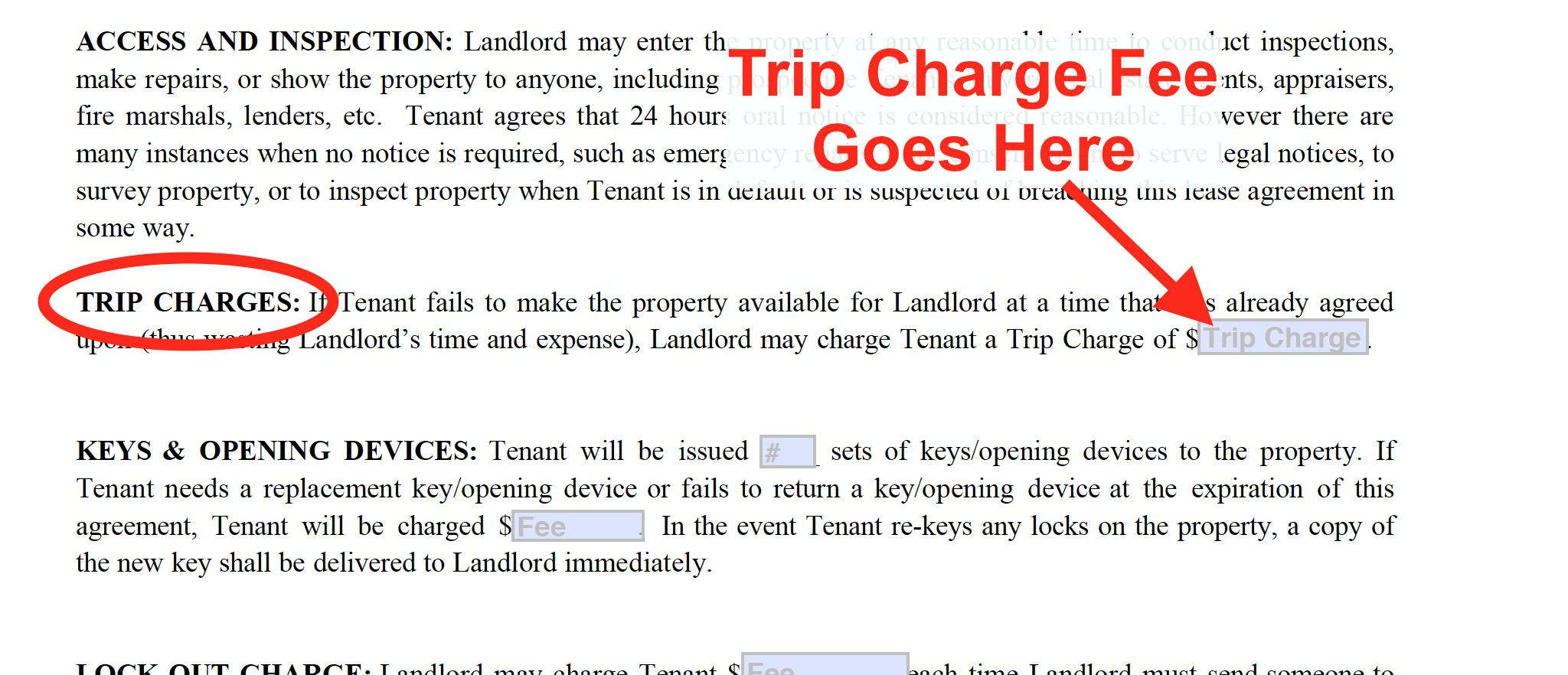
Keys and Opening Devices
How many keys will your tenant get and how much will you charge if they lose them? That’s the gist of this section.
How Many sets of keys will you give them?: It’s typical for a Tenant to get 2 sets of keys, or a Key set for every adult and older child living in the property. When you are filling this section out, simply ask the Tenant how many sets of keys they need. Don’t give them a bunch of extra key sets for no reason. It’s not safe for them or for your property to have lots of unnecessary keys floating around. Then input into the box the number of keys (or sets of keys) they will receive.
How much will you charge them for Key Replacement?: When keys get lost (they always do – we’ve all done it), there is an expense incurred. You need to go to the hardware store, and pay to have your master key copied. So we need to charge the Tenant for the time and expense of replacing their key. I believe $30 is sufficient for copying a key, but if they lose a garage door opener or key “FOB” then of course that will be more expensive. So go ahead and put into the second box in this paragraph what you will charge the tenant if you need to replace their key.
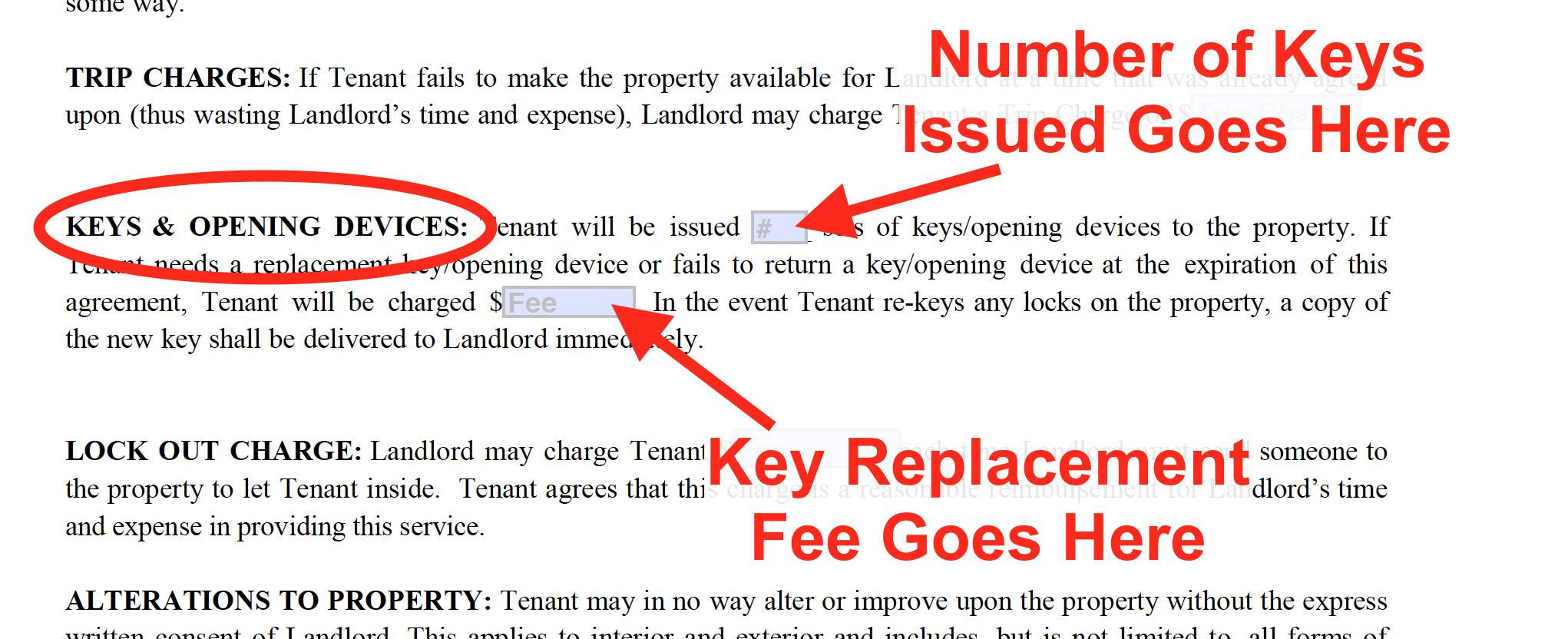
Lockout Charge
Ever get locked out of your home or apartment? It happens. It happened to my 65 year old mother, and she had to walk to a neighbor’s house to call me and drive over to let her in. So like some of the situations above, we are happy to help out our Tenants in this situation, but there is a time and expense involved. How much to charge them? Well, think about if you will need to get out of bed at 2:00 AM in the morning to drive for 30 minutes to let in your Tenant who got locked out after a night of drinking. Will a mere $10 compensate you for that headache? Probably not. I believe $30-$50 is sufficient, but it’s up to you. Again, don’t go too high or unreasonable or else it won’t be enforceable later on. So put in this box what you will charge them as a “lockout fee” or “lockout charge”.
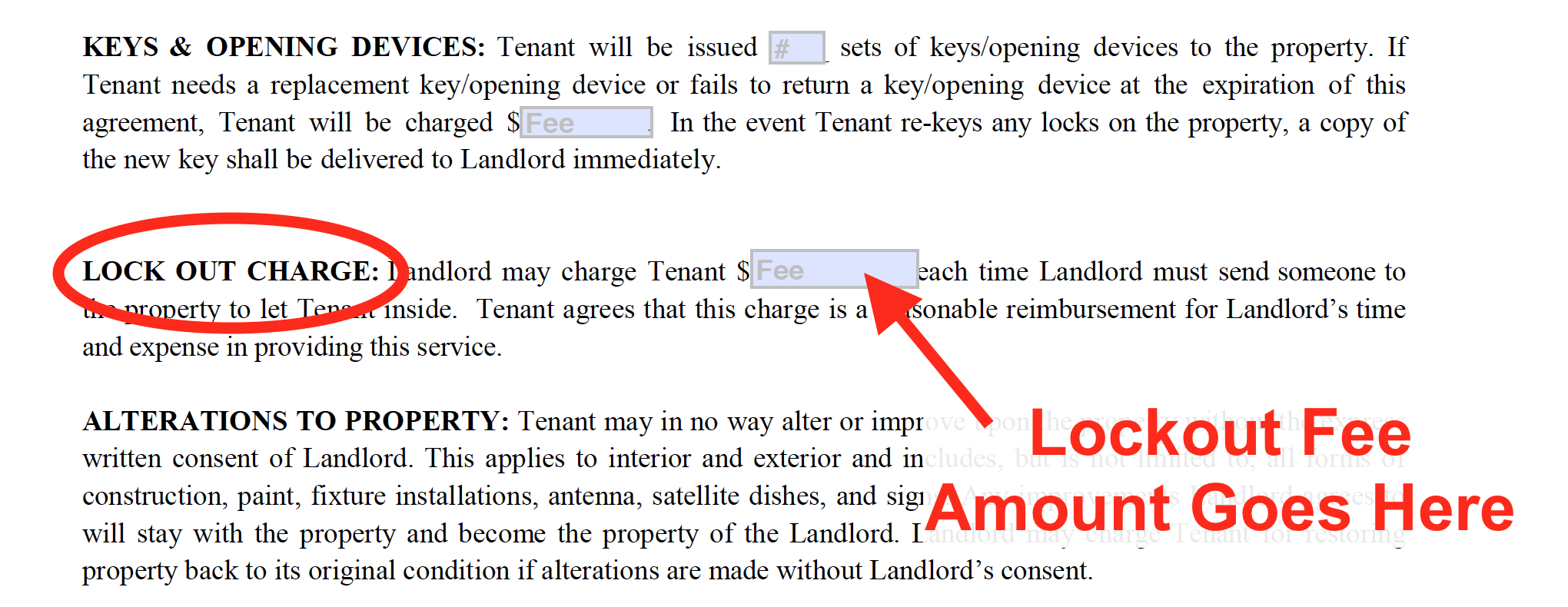
Lead-Based Paint Disclosure
This section is important, and you need to check the appropriate boxes. Prior to 1978, lead was used in paint on residential homes. We now know that lead causes lots of health problems for children and pregnant women. I personally would not let my family live in a house that still had lead-based paint. However if your property does have lead based paint, you need to disclose it to the Tenant.
Was your home build Before 1978 or After 1978?: This part is easy. Find out when your property was built (you can look up your property on Zillow for this) and then check the correct box. If your property was built 1978 or after then you’re done. Yay. If your property was built before 1978 then check that box, and we need to look at the next 4 check boxes:
Do you have knowledge of Lead-Based Paint on this Property?: If yes, check this box.
Can and Will you Provide the Tenant with all the records you have about the hazard?: If yes, check this box.
Do you have NO knowledge of Lead-Based Paint on this Property?: If that is true (that you don’t have any knowledge), then check this box.
Have you given the Tenant the EPA pamphlet entitled “Protect Your Family From Lead in Your Home”?: Go ahead and check this box. Why? Because I’m giving you the form right here: Click Here to Download “Protect Your Family From Lead in Your Home” . Download it, print it, and give it to your Tenant.
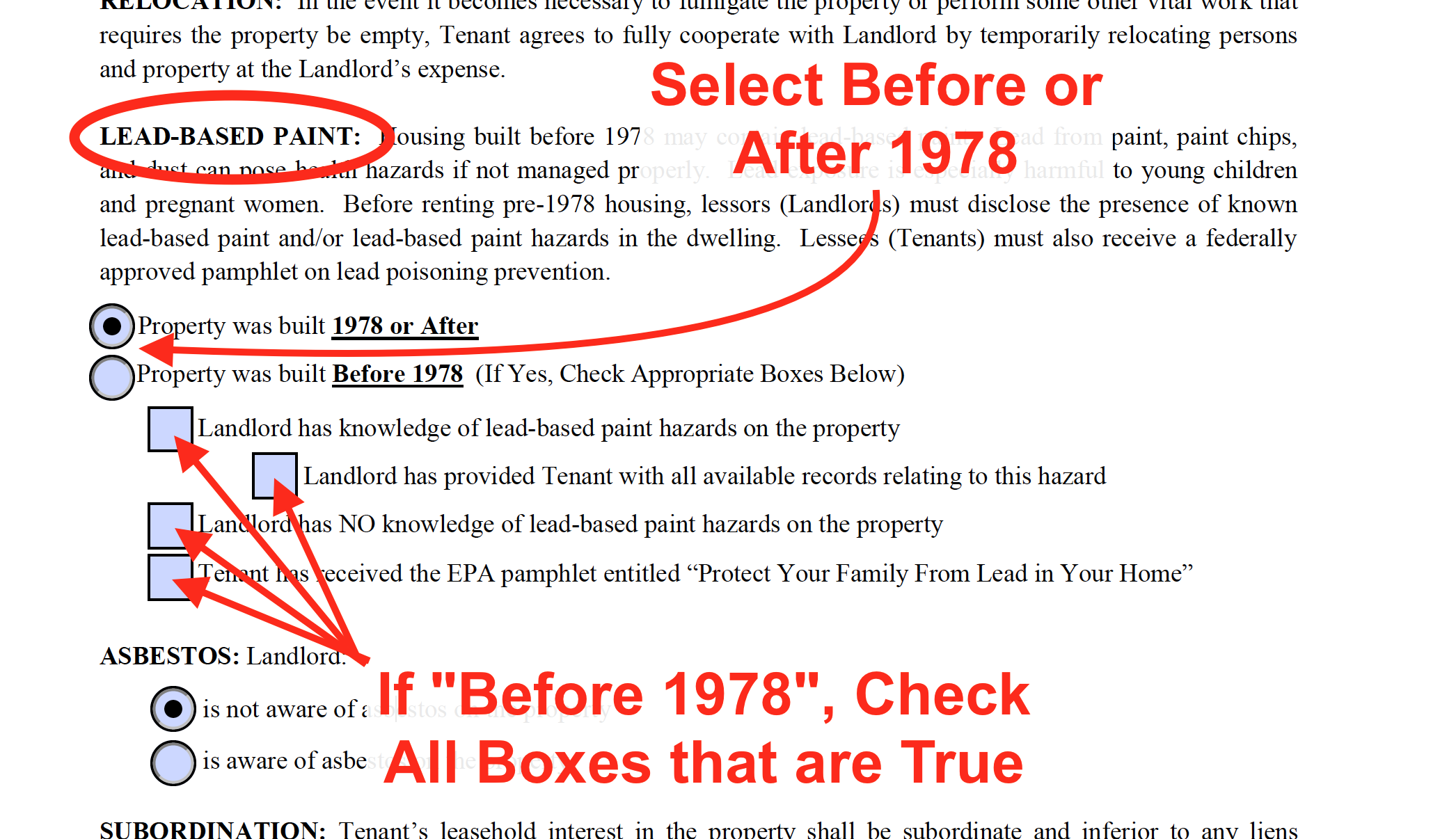
Asbestos Disclosure
Asbestos was used as a building material throughout the 20th century, but we now know that asbestos dust causes cancer and other diseases. 100,000 people a year die from diseases related to asbestos exposure. Therefore, it’s important to disclose if your property has asbestos. In this section, simply check if you are “not aware” or are “aware” of asbestos on the property.
Special Provisions Section
This is my favorite section, because it allows you to customize the lease and input things that are important to you. You can also put things that are not specifically addressed in the standard lease language.
For example, you might want to specify that a tenant can smoke on the patio, but not inside, as mentioned above.
You might want to add a part that Tenant needs to water the foundation once a week, or that there is a certain gate that is to remain locked.
I personally like to include language that let’s the Tenant know that I’m serious about getting the rent on time. I put, “Tenant acknowledges that Landlord has a “Zero-Tolerance” policy for late rent payments. I then have the Tenant initial that. It’s better to be strict up front when there is no issue, than have to be strict later on, and the Tenant will act surprised that you’re not okay getting the rent on the 7th of the month.
So think about what else you need in your lease, that pertains to your property, and put it into this section.
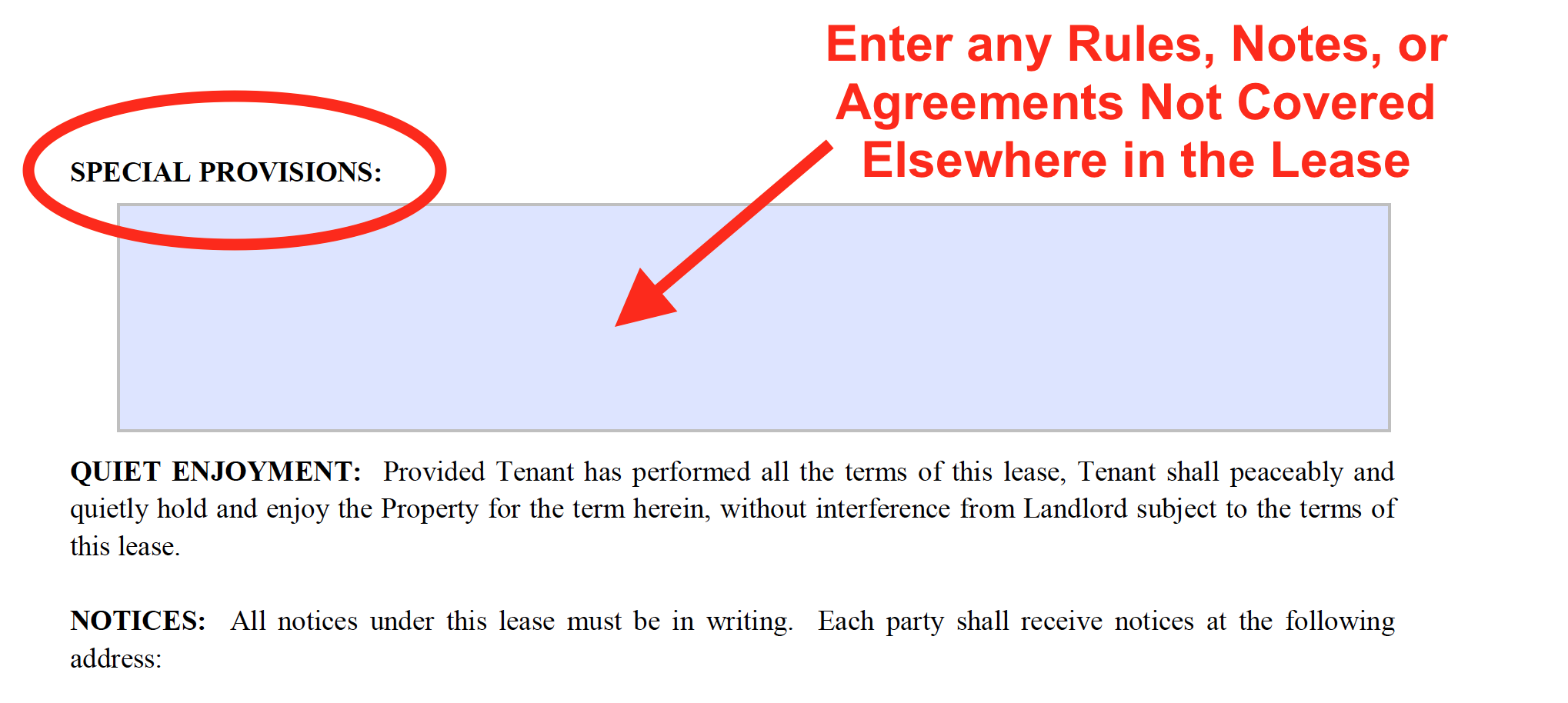
Notices – Communication between Landlord and Tenant
A notice is just sending somebody a message. But because a lease is a legal agreement, you need to be a little formal about sending messages to the Tenant, because they will be saved, and could always come up later in court. You also need to be able to prove that you send certain notices, such as security deposit deduction letters, eviction notices, etc.
Landlord Notice Address: So in this section, put in the physical address where the Landlord (you) can receive mail and will be checking the mail frequently. This way if the Tenant sends you a legal document or letter, you will get it!
Tenant Notice Address: And then ask the Tenant if they want to receive mail in a place other than the property they are renting, such as a P.O. Box. If not, the place to send notices to the Tenant is usually the rental property itself. So input the Tenant’s preferred address under the “Tenant” Section.
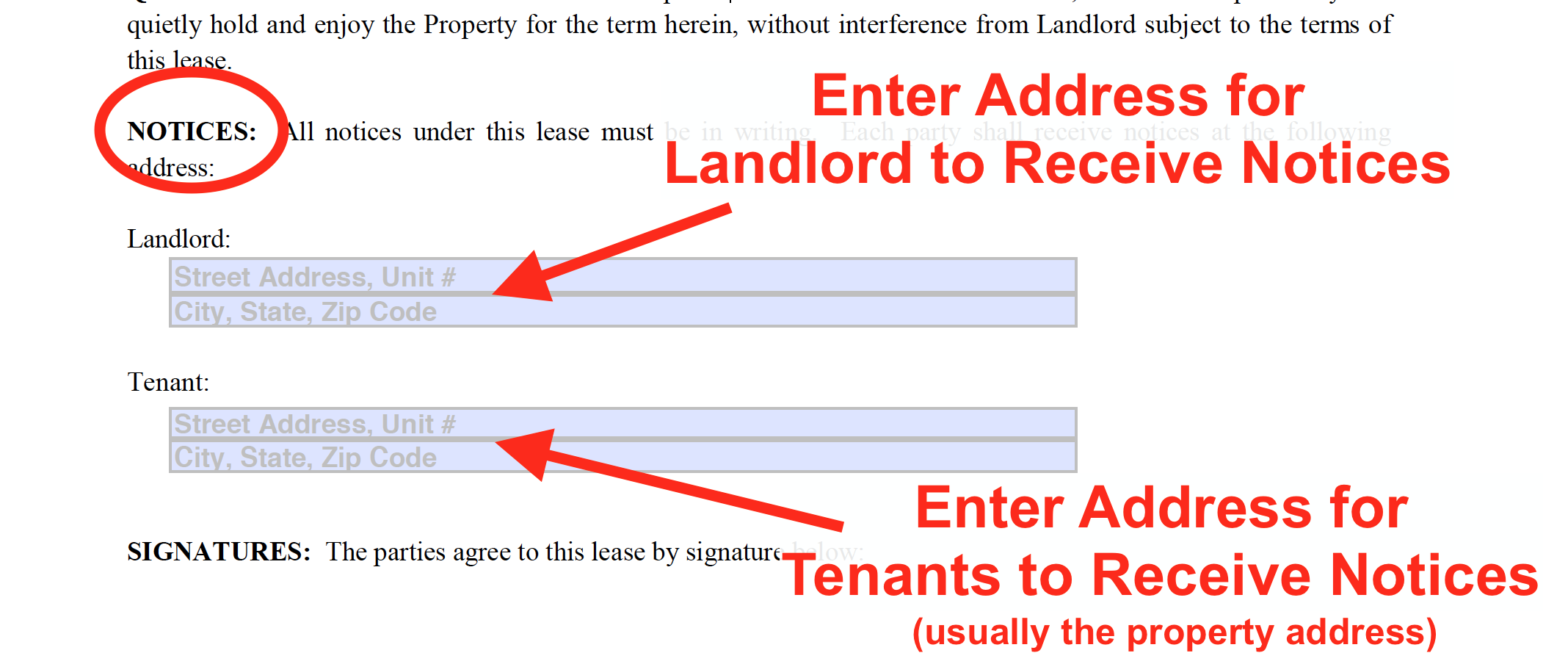
Signatures – Let’s Make this Legal!
There are a few things you should know about signing your residential lease. Below I will go over the Best Practices for Signing Your Residential Lease Agreement, but for so let me just tell you the mechanics of filling it out.
Print Names: Type or Print the Name of the Landlord (or Landlords) underneath the signature line. Then type or print the Names of each adult Tenant underneath the lower 4 signature lines. When you meet the Tenant to go over the lease and sign and date it, your names will already be nicely under the signature lines, ready to go. If the Landlord is an LLC or Corporation that you own, then type or print the name of that entity, and the representative of that entity (you, perhaps) who will sign for it.
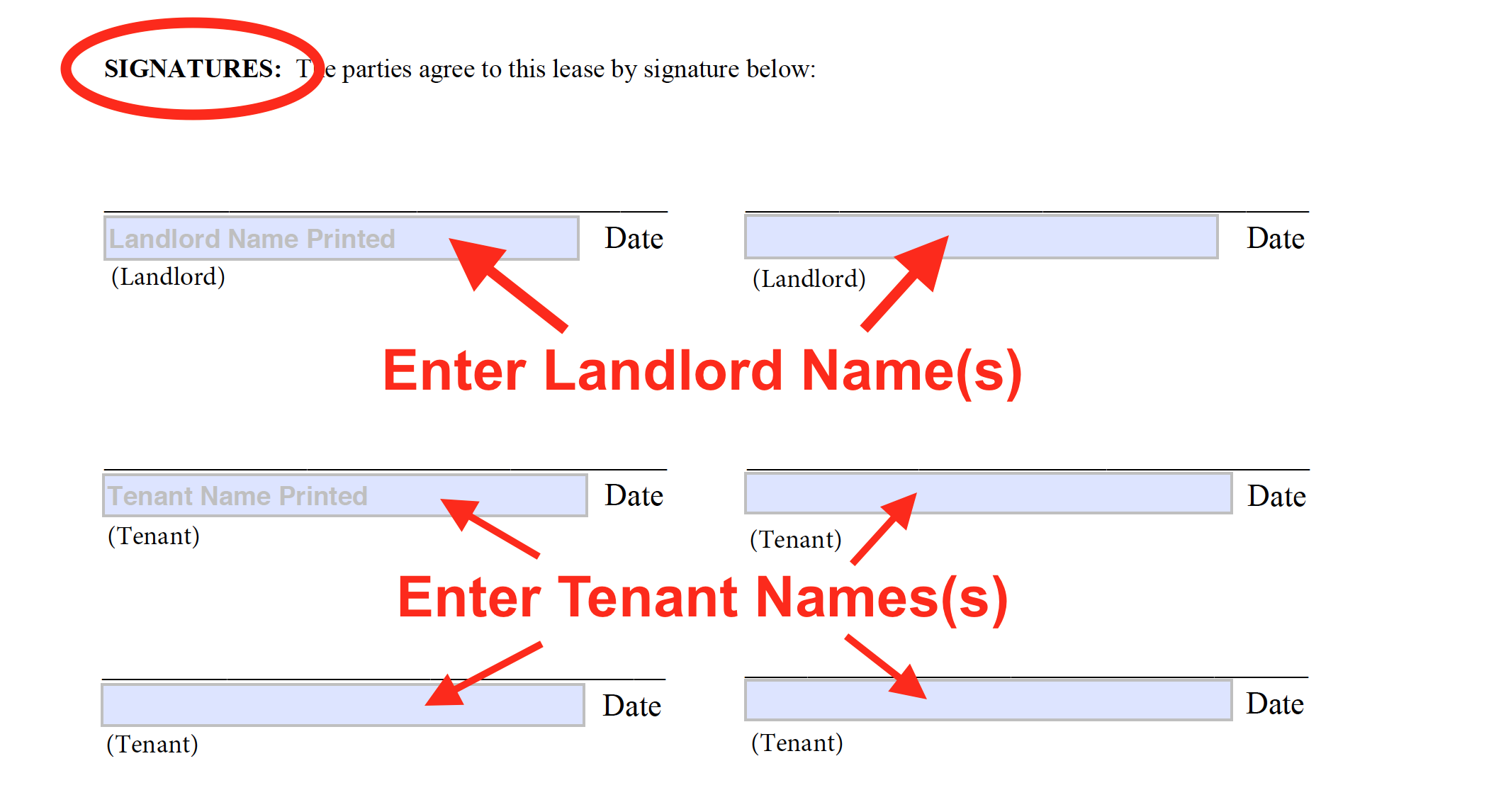
Congratulations! Now your Residential Lease is ready to Print and Sign (or sign if you were filling it out by hand)! Go ahead and Print it Out and feel good that you have a completed lease. Make sure you save it in the filled out format, so that you can use it over and over with just making minimal changes.
Okay, it’s time to meet your Tenant to sign the lease. Keep reading to learn the best way to do this.
How to Actually Sign a Lease with Your Tenant – Best Practices

First, let me get this tip out of the way: Do not sign the lease first and then send the signed lease to your tenant. Why? Because now they can hold onto the lease (that has your signature on it) and take their sweet time signing it. If they don’t get back to you for a while, you cannot rent the property to someone else for fear that this first tenant will finally decide to sign the lease, show up with it (with your signature on it), and then sue you in court for breaking it! So no matter what, even if you sign the lease in person, have the tenant sign first.
My recommendation is to sign the lease in person with the new tenant. Let’s call it a “signing ceremony.” At this ceremony, you get to go through the lease with the tenant, going over the rules and having them initial each page. By doing this, it makes it less likely that the tenant will break those rules. Why? Because they now feel like they know you, and you have verbally gone over the rules with them. Contrast that to a tenant who quickly signs a lease in their email without reading it.
Also, summon up your courage and say something like, “I just want you to know up front that I am very strict about receiving the rent on time.” I know it is hard to say this when everybody is happy and excited. But I promise you that if you don’t, the tenant may think of you as a bill they can put off when things are tight. And you don’t want that. You want them to think, “I will pay my rent first, and then figure out my other bills.” So please let them know up front that you don’t play games.
Okay, so have the tenant initial each page and then sign and date it on the last page. Get their Deposit and First Month’s rent from them (and any pro-rated rent due) in the form of Cash, Certified Check, or Money Order. No personal checks for this part! I’ve been burned bad here, and it wouldn’t have happened if I insisted on certified funds. At this point you can give them the keys (if this is when the lease actually begins).
You will then initial and sign the lease as the Landlord and send them a copy within the next few days.
As the tenants get settled in, expect some questions from them for the first few weeks. Then after that things usually (and hopefully) get smooth.
9 Residential Lease Agreement FAQ’s
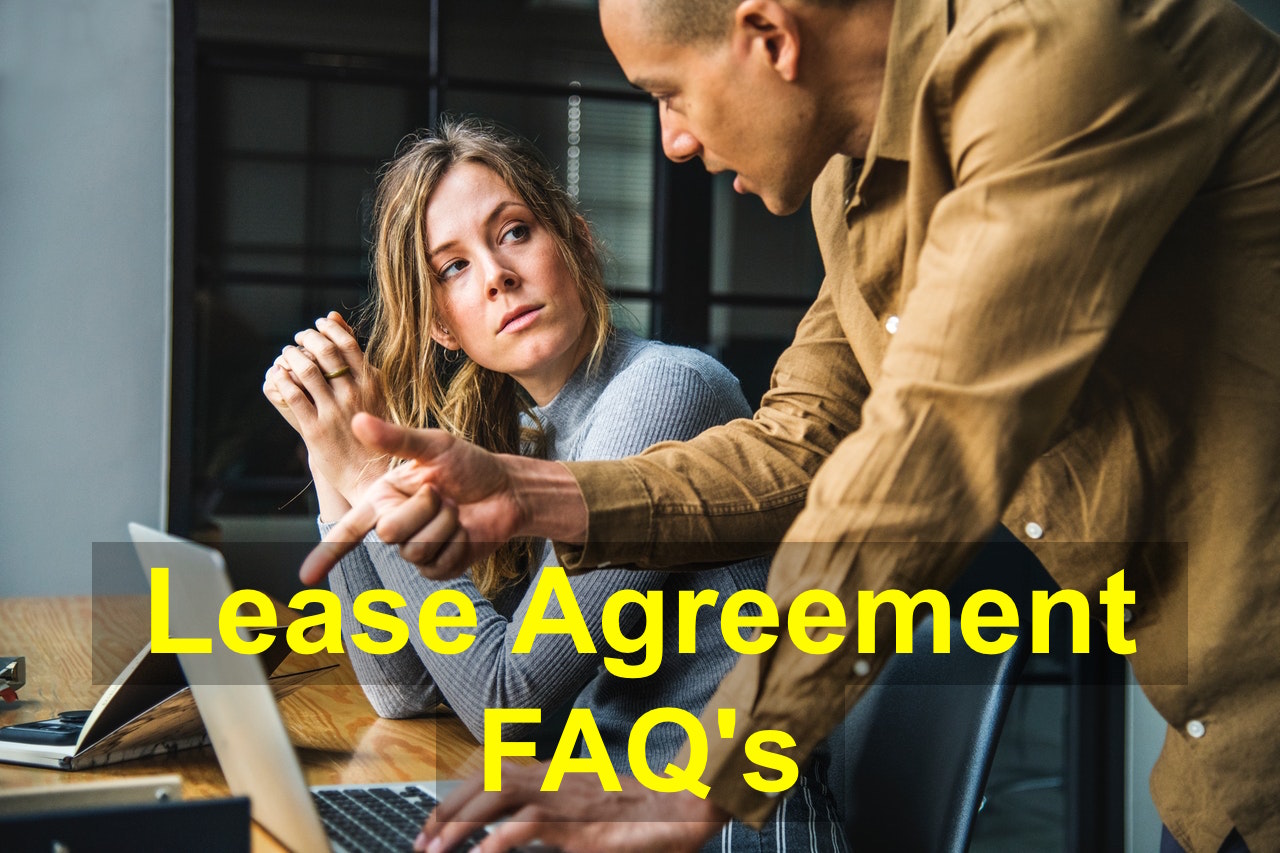
Here are some Frequently Asked Questions and Answers about Residential Rental Lease Agreements:
Question 1: Are verbal (oral) lease agreements legally binding?
Answer: They can be, but if you need to enforce a verbal lease, you will need to be able to provide evidence. And that evidence is tough to show without a written lease. If you are thinking of renting your property to a friend or someone else with just a verbal agreement, please STOP! Do yourself (and everyone else) a favor and create a written lease agreement. If anything, it will cause you to stop and think about potential problems now, up front, and not later when it’s too late.
Also please be aware that because of a legal rule called the “Statute of Frauds,” any lease that will not end within one year from its commencement must be in writing, or else it will not be enforceable by the landlord.
Question 2: How much money should I charge the tenant for monthly rent?
Answer: You should charge the “market rate.” No more, no less. The “market” rate for rent is simply what other similar properties in your geographical area are charging. By similar, I mean the same number of bedrooms and bathrooms, similar square footage, and similar features. My favorite place to look first: I check the Rent “Zestimate” on Zillow.com.
IF you charge more than the “market” rent, tenants will eventually figure it out and move on. If you charge too little, you will not make as much money, but may also have problems keeping up the property.
Question 3: How much can I charge for the Security Deposit?
Answer: This depends on what state you live in. Some states have no rule and let you charge as much as you think necessary. Other States cap the amount you can charge. For example, California says that the maximum security deposit you can charge is an amount equal to 2 month’s rent, or if the home is already furnished, then 3 month’s rent. Check the Table Below to find out your State’s Maximum Security Deposit.
Question 4: Since I own the rental home, can I still go over there whenever I want?
Answer: Generally, No. Would you like your landlord showing up when you’re in your underwear, relaxing on the couch? However the landlord does need to go into the rental home for plenty of reasons. Therefore, many states have laws that regulate the amount of time the landlord must give the tenant before showing up. If your state does not have a law, it does not necessarily mean you have free reign to go over there. You should still provide the tenant with reasonable notice, and of course don’t show up at inconvenient times (dinner time, bedtime, nighttime, etc.). Check the Table Below to see if your state regulates the “Landlord Access” notice time.
Question 5: What is NOT Allowed in my Rental Agreement?
Answer: First, anything that violates the Fair Housing Act is prohibited, and will get you in big trouble if you violate it. For a landlord, the Fair Housing Act basically says that when you are renting to somebody, you cannot ask about, or make a decision of renting to somebody, based on their race, color, national origin, religion, sex, familial status, or disability. You also better not discriminate on the basis of sexual orientation, because there are plenty of other new regulations affording protection in that regard. So don’t put anything discriminatory in the lease.
The lease also cannot waive basic rights that then tenant has. For example, the lease cannot waive the tenant’s right to get their security deposit back, their right to sue the landlord in court, or their right to live in a “habitable” property.
Question 6: What is the difference between a Lease Agreement and a Rental Agreement?
Answer: Many people use these terms interchangeably. However technically, a residential “Lease Agreement” is an agreement to rent property for a specified amount of time (called a term). A residential “Rental Agreement” is a periodic agreement, such as a month-to-month agreement. As a lawyer and a landlord, I recommend that you always try to lease to tenants for a specified term, such as a 6 month lease or a 1 year lease.
Question 7: What to do if Tenant breaks the lease and moves out?
Answer: If the tenant still has time left on their lease, and they simply abandon the place, then you have a “duty to mitigate.” This means you need to clean up the place and try to get it rented again. However, the tenant who broke the lease is liable (they have to pay you) for the rest of the lease up until a new renter moves in. They also have to pay you for any damages and expenses they caused by breaking the lease, including the expenses you incurred finding a new renter. If you can find where they moved, you’ll need to send them a demand letter for the money they owe, and maybe even sue them if necessary, and if you think it’s worth it.
Question 8: How much notice does a landlord have to give if not renewing lease?
Answer: Look at your lease! Most leases say 30 days before the lease expires. If you don’t have a lease, and are in a month-to-month, then 1 month written notice is most likely going to work. However the more notice you give, the easier it will be for the tenant to find a new place.
Question 9: Is there a grace period for signing a rental agreement?
Answer: Generally, No. Once the tenant signs and pays the deposit and first month’s rent, there is usually no turning back. That is why you should get these monies in certified funds (not personal checks) at the time of signing. If the tenant does back out, you will have the duty to mitigate (still try to rent to someone else), and you will decide if it’s worth it to pursue them legally for the amount they are responsible for.
Question 10: What Should Be Included in my Lease Agreement?
Answer: Nolo.com writes that there are at least 10 Lease Terms that must be included in a Lease or Rental Agreement. They are:
- Names of All Tenants
- Occupancy Limit
- Term
- Rent
- Deposit & Fees
- Repairs & Maintenance
- Landlord Entry
- Restricts Illegal Activity
- Pets
- Other Restrictions
So we have answered some common questions, and gone over how to fill out the lease, but now let’s dive deep and explain every single section of the lease. I’m essentially about to translate the “legalese” into plain, dumbed-down language. Deep breath, keep reading.
What Does Each Section of the Lease Actually Mean
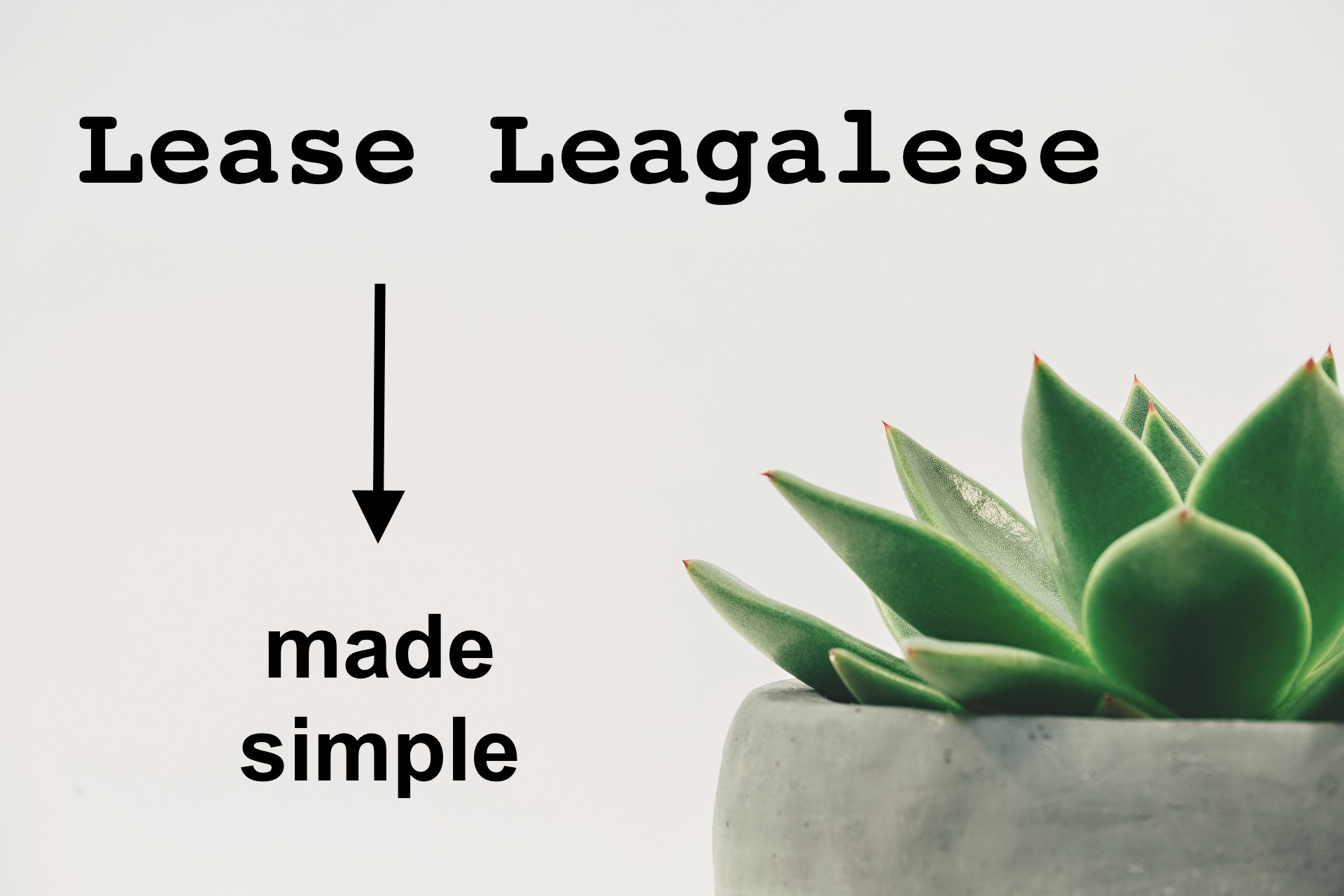
So my “Standard” Residential Lease obviously has a lot of what people call “Boilerplate” or “Legalese” language. My view as a lawyer is that legal writing should be in “plain language” as long as it still is legally binding. There is no reason to make yourself sound smart by using legalese or legal mumbo jumbo. So I used plain language as much as I could, but there was only so much simplifying I could do. So I still think you could benefit from a “Leases for Dummies” simple explanation of each section. So here we go from the beginning of the lease…
PROPERTY: This is the house or apartment that you will be renting to your renters (tenants). We identify it by putting in the address, and the legal description, which you can find in the deed to the property or the online property records.
PARTIES: No, we are not having a party. “Parties” just means the people doing the lease. So the Landlord (owner of the property) and the Tenants (the renters). We simply identify them by putting in their legal names.
TERM: Not a pregnancy. “Term” refers to how long the lease will be for. 1 year? 6 months? So we put in the start date (called the “Commencement date”) and the end date (called the “Expiration date”).
OCCUPANCY DELAY: Sometimes the Landlord cannot give the Tenant the keys on the day they promised. Maybe the prior tenant did not move out on time, or maybe the Landlord is finishing painting the place and needs a few more days. This section simply says that the tenant will not have to pay rent during that time. It also says that the Tenant can cancel the lease if the landlord cannot turn over the keys within 30 days of when they are supposed to have them! Just some advice, if you can help it, please don’t be that jerk Landlord who doesn’t turn over the keys when promised. It’s a really bad start to the relationship.
AUTO RENEWAL / NOTICE OF TERMINATION: This section says that in order to end the lease at the expiration date, you must give the tenant a letter 30 days in advance (1 month before the lease ends). Otherwise it will automatically renew as a month-to-month. If the Tenant plans on moving out at the end of the month, they must also give the Landlord a letter 30 days before the lease is up, or else it becomes a month-to-month. If this does indeed happen, and it becomes a month-to-month, then to end the month-to-month either the Landlord or Tenant must give a letter 30 days before they want to end it.
RENT: Money Time. It’s why we do all this work!
- The “Monthly Rent Amount” is the amount the tenant will pay you each month during the lease.
- THE “Prorated Rent” is simply rent covering part of the month at the beginning of the lease. So if the tenant moves in before the 1st, they will pay partial rent for those days, and then a full month’s rent on the first. You can see my example calculation for this above
- The “Due Dates” are the days when the tenant must give you money. This sections notes the due date for the month rent (usually the 1st), when it is considered late, and when the first full monthly rent payment is due.
- The “Payment Information” Section tells the tenant where to mail or drop off the rent.
- The “Payment Methods” section tells the tenant what forms of payment you accept.
LATE FEES: If the tenant does not pay the rent by the due date, this section says what the amount is that they will have to pay as a late fee. It has an initial late fee, and then a daily late fee (smaller than the initial fee). So the late fees grow daily if the rent is not paid.
RETURNED PAYMENTS: Landlord gets to charge a fee if the tenant’s rent check bounces. This is only fair as the landlord will incur bank fees and it’s a big headache overall.
SECURITY DEPOSIT: A Security Deposit is an amount of money that the tenant gives at the beginning of the lease for the landlord to hold. What for? At the end of the lease, the landlord can use that money to pay for any damage that goes above and beyond normal “wear and tear”. The landlord must return the rest of the money along with a letter explaining the deductions, in detail, line by line. It’s best to take pictures of the damage also.
PETS: Will the landlord allow pets or not? If yes, how many and what kinds of pets? I recommend limiting the number of pets, and also not allowing dangerous pets (certain dog breeds – sorry dog lovers). This section also allows a non-refundable pet deposit. This is important because almost all pets cause damage.
UTILITIES: This section says that the tenant will pay for all the utilities, such as water, electricity, etc. But it leaves a space for the landlord to note any utilities that the landlord will pay.
OCCUPANTS AND GUESTS: How many people will be allowed to live on the property during the lease? And just so the tenant doesn’t let people move in and call them “guests,” this section limits how long any guest can come stay on the property.
PARKING AND VEHICLES: Ever seen a house with 6 cars in the driveway and only 1 of them works? We’re trying to prevent that here. This section limits the number of cars on the property, says they all must be licensed and working, and tells the tenant where they may and may not park (no parking on the lawn).
SMOKING: Is smoking allowed or not? This section also says that if the tenant smokes in a non-smoking rental, then the landlord can charge them to remove the smoke smell.
ACCESS AND INSPECTION: This section explains that the landlord may come into the rental property for inspections, repairs, etc. It says that 24 hours verbal notice (does not need to be in writing) is considered reasonable, but also says that sometimes (in case of emergencies), the landlord may come over with no notice at all.
TRIP CHARGES: If the landlord told the tenant that they were coming over for some reason, and the landlord cannot get in because of the tenant, then the landlord can charge a fee called a “trip charge.” The purpose is to compensate the landlord for wasting her time.
KEYS & OPENING DEVICES: How many keys or sets of keys will the tenants get, and what is the fee if they lose a key and the landlord has to replace it?
LOCK OUT CHARGE: What is the fee if the landlord has to drive over to the property to let the tenant inside because the tenant has locked themselves out?
ALTERATIONS TO PROPERTY: The tenant cannot change the property at all, meaning they cannot paint, do construction, install satellite dishes, etc., unless the landlord agrees to it in writing. If the landlord does indeed agree to it, then when the lease is over, the landlord gets to keep what is done. If tenant makes alterations without getting permission, the landlord can make the tenant pay for making things go back to their original condition.
PERMITTED USE: The tenant can only use the property as a private residence. They cannot use it to run a business, and they cannot sub-lease it to others without the landlord written permission. The tenant also may not use the home as one big storage unit.
COMMON AREAS: Landlord will not pay optional common area fees for tenant to use that common area. For example if there is a community pool that is optional to pay for, the tenant is welcome to pay for that, but the landlord will not.
SIGNAGE: The landlord can put “For Rent” or “For Sale” signs in the yard at any time.
MOVE-IN CONDITION: This says that the tenant has seen the property and accepts it “as-is.” It also says that the tenant has made an list of any damages they noticed and has given it to the landlord so they will not be charged for those damages at the end of the lease. The list is not a request for repairs, it is just to note the “pre-existing” condition when they move in.
NEIGHBORHOOD CONDITION: I once had a tenant break a lease because they didn’t like the noise of the cars on the street (it was a quiet residential street so I had no idea what they were talking about). This section states that the tenant agrees that they like the neighborhood and it satisfies their needs. It helps protect against them breaking the lease because of the neighborhood.
PROHIBITIONS: This is a “laundry list” of things the tenant is not allowed to do. It’s pretty common sense. It includes things such as disturbing the neighbors, criminal activity, and my favorite, hoarding.
HOA RULES: HOA stand for “Home Owner’s Association”. If the property has an HOA, this says that the tenant must follow their rules and reimburse the landlord for any expenses caused by breaking their rules.
OTHER RULES: More rules!? Yep. This section says that the landlord can give the tenant more rules to follow during the lease. Why? Maybe the tenant decided to park a licensed, operable helicopter in the driveway, and argued that it complied with the vehicle portion of the lease. But you don’t want it there. You can simply make a new rule that says, “No Helicopters on the Property”.
CRIMINAL ACTIVITY: The tenant can be evicted if the tenant or their guests engage in criminal activity. It then lists the types of crimes that apply. But it also states that a victim of domestic/family/sexual violence cannot be evicted just because the perpetrator is also a tenant. It’s not fair to the victim, and it might cause the victim more harm. So in this case you would just evict the perpetrator of the violence.
MAINTENANCE: The tenant is responsible for taking care of the property. Pretty much all the things a homeowner takes care of, the tenant must do, including keeping the property clean and safe, changing air filters, and notifying the landlord of any needed repairs.
REPAIRS: Tenant must request repairs in writing. But if it’s an emergency (think burst pipe), they may call the landlord because that’s faster. Also, tenant will have to pay for repairs for damage that tenant causes.
SMOKE ALARMS: Tenant will not mess with them except to replace the batteries and keep them working.
YARD AND LANDSCAPING: Tenant is responsible for the yard and landscaping. They must water, mow, trim, weed, etc.
DRAIN BLOCKAGES: Tenant is responsible for the plumbing costs of fixing drain blockages caused by the tenant putting items down the drain.
MOVE-OUT OBLIGATIONS OF TENANT: This says that when the tenant moves out, they will:
- Give it back in the same condition they received it
- Have removed all trash
- Have Cleaned it
- Return all keys, garage door openers, etc.
It also says that the tenant can request an inspection so the landlord can point out problems and the tenant can have them fixed by a professional.
EARLY TERMINATION: This says that the Landlord or Tenant cannot get out of the lease simply because of life’s usual events (job change, school transfer, etc.). The purpose of a lease is to give each side some certainty. However, the lease can be terminated early for certain reasons, such as non-payment of rent, lease violations, criminal activity, etc.
DEFAULT: If the tenant causes early termination by violating the lease, not paying rent, etc., then the tenant is legally in “default”. This means that landlord may now demand that they move out, and tenant will have to pay all the costs associated with that process.
DEFAULT/TERMINATION NOTICE: This paragraph says that if tenant has broken the lease, then the landlord will give them a written Eviction Notice before the Eviction Lawsuit is filed in court.
EVICTION: Once the Eviction Notice has been given to the tenant and the time period in the notice has expired, the landlord will file for eviction in court. It also confirms that the landlord will not force out the tenant without a court order (that’s not allowed).
MILITARY: A military service member can get out of the lease with 30 days written notice by showing the landlord proof that:
- They have orders to move 35 miles or more away, or
- They have orders to live in barracks/gov’t housing for more than 90 days
I fully support this – these men and women protect us and should have some leeway in these situations.
FAMILY VIOLENCE: Victims of family violence may have certain rights that allows them to get out of the lease with 30 days written notice. This is because they may need to flee for their safety.
SEX OFFENSES OR STALKING: Victims of sexual violence or stalking may also be able to get out of their lease with 30 days written notice. They also may need to flee for their safety.
HOLDOVER: “Holdover” means that the tenant stays longer than they are supposed to. This section says that if they do this, they will have to pay the landlord for all the problems this causes, including lost rent and lost future tenants who couldn’t move in because these current ones didn’t move out in time.
ABANDONMENT: If the tenant disappears or moves out without giving notice (abandons the property), the landlord may take back the property, throw away what’s left inside, rent it to somebody else, and hold the tenant responsible for defaulting and all the costs associated with the situation.
ASSIGNMENT AND SUBLETTING: The tenant cannot “assign” or give the signed lease to somebody else to use unless the landlord approves it in writing. Also, the tenant may not “sublease” or lease to somebody else who will pay the tenant rent, or pay rent directly to the landlord under the original lease, unless the landlord approves it in writing. The landlord does not have to do a sublease if they don’t want to, unless there is a local law that says they have to.
UNAVOIDABLE EVENTS: If there is a fire, or flood, or some other disaster that is not the tenant’s fault, then the tenant can move out and will not owe any more money for the rest of the lease.
RELOCATION: If the landlord needs the tenant to move out temporarily so the landlord can fix something really important, the tenant promises to cooperate by moving out and the landlord will pay for it.
LEAD-BASED PAINT: Homes that were built before 1978 might have lead-based paint. Why is this a problem? Lead is poisonous and being around lead causes health problems, especially for kids and pregnant women. So renters have a right to know if they are moving in a home that had or has lead-based paint. This section makes the landlord say if the home was built before 1978, if the landlord knows about any lead-based paint hazards, if they have provided the EPA pamphlet about it to the tenant (you can get it here), and if landlord has provided any records they have about it. FYI the landlord must provide the pamphlet.
ASBESTOS: Asbestos was used as a building material for many years, but it causes lung cancer and other health problems. In this section, the landlord simply needs to say whether or not she’s aware of any asbestos on the property.
SUBORDINATION: This section is probably the most legalese section in the whole lease. It brings me back to my property law days in law school. It’s important, and it’s also hard to translate into plain language. It essentially says that the landlord can refinance the property, take out a loan against it, and do other legal things related to the property, and the tenant won’t have any rights regarding that stuff.
INSURANCE: The landlord is not paying for the tenant’s renter’s insurance. So if the tenant want’s their stuff inside the home covered by insurance, then they need to buy their own insurance. This section also says that the tenant cannot do things that make the landlord’s insurance costs go up.
LIABILITY AND INDEMNIFICATION: This section is also pretty legalistic, but it basically says that the landlord will never have to pay the tenant for injuries or damages (not totally true but lawyers put it here anyway), and that the tenant will have to pay the landlord for damages the tenant or tenant’s guests cause.
JOINT AND SEVERAL LIABILITY: Each tenant is responsible for all obligations in the lease. The obligations don’t get divided amongst the tenants. For example, If there are 3 tenants, each of them is responsible for the total rent, even if they each pay 1/3. The landlord can evict all 3 of them if only one of them does not pay her portion.
ATTORNEYS FEES: Tenant has to pay for the landlord’s lawyer costs if the landlord has to hire a lawyer to enforce the lease.
WAIVER: If the landlord lets the tenant pay late or violate the lease, the landlord can still enforce that part of the lease the next time, and can still enforce every other part of the lease.
ENTIRE AGREEMENT: These 9 pages are the entire agreement. There are no verbal agreements that change the lease. The lease can only be changed in writing.
BINDING EFFECT: This means that the lease is real and has effect.
CONTROLLING LAW: Although similar, the property laws are different in each state. This section says that the laws that apply to the lease are the laws for where the property is located. So if the property is in Florida, then Florida laws apply.
SEVERABLE CLAUSES: This means that if a judge says part of this lease is not valid or enforceable, then the rest of the lease is still enforceable.
REPRESENTATIONS: This says that the landlord and tenant are both old enough to sign the lease (probably age 18 in most states, if not all of them). It also says that if the Tenant has lied on this lease or the rental application, then the tenant will be in default of the lease (and the landlord could terminate the lease).
MODIFICATIONS: This says that if the lease is to be changed, it must be done in writing and of course agreed to by the landlord.
RECORDING: This part says that the lease will not be filed in the local property records, and if the tenant does file it in the property records, then the landlord may say the tenant defaulted on the lease.
CONSTRUCTION: In this lease, regardless of whether you see the word “Tenant” or “Tenants”, it is referring to all the Tenants who sign the lease, not just one of them.
CAPTIONS: This means that any notations (captions) in the lease are just to help filling it out.
SPECIAL PROVISIONS: This is a nice section where you can put anything extra that you need to. I like to add this phrase: “Tenant acknowledges that Landlord has a Zero-Tolerance Policy for late rent.” It does not have any legal meaning, but is a way to show the Tenant that your Landlord business is real business, and you are not a schmuck who will be taken advantage of.
QUIET ENJOYMENT: This section has been in leases for time immemorial. It basically means that if the tenant does what they are supposed to do and follows the terms of the lease, then the landlord will leave them alone and let them use and enjoy the property in peace!
NOTICES: This is where the landlord and the tenant put the address where they want to receive letters and formal notices from each other. For the tenant, it will usually be the address of the property they are renting. For the landlord, it will be their home, office, or wherever they want communication from the tenant sent.
SIGNATURES: Let’s make it happen! This is where we type or print the legal name of the landlord and the tenants, and then they have to sign and date above their names. The names in the signature area should match the names of the parties at the beginning of the lease. Don’t forget, the landlord and tenant should initial each page at the bottom in the space provided, and should sign and date the last page.
So there you have it — boilerplate residential lease agreement language translated to “plain language”. Now let’s take a look at the Security Deposit Limits and important Time Periods for each state:
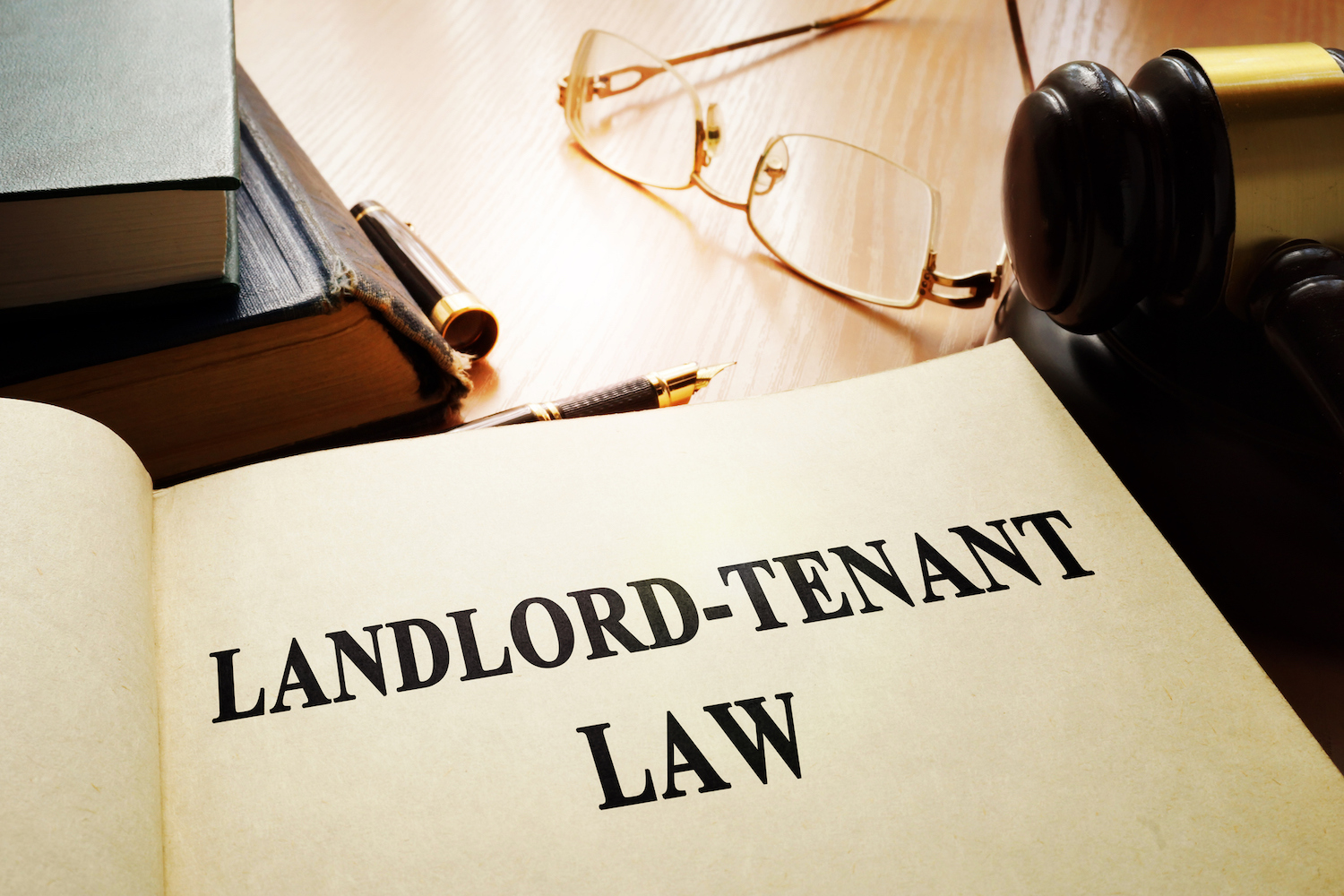
Residential Lease Agreement Reference Chart
This table shows the Maximum Security Deposit amount the landlord can charge (amount equal to), when the landlord must give back the Security Deposit by, the amount of advance notice the landlord must give the tenant to enter the property, and a link to the Landlord-Tenant laws for each U.S. State.| State | Security Deposit No More than: | Return Security Deposit within: | Notice Time for Landlord Access | Landlord Tenant Law |
|---|---|---|---|---|
| Alabama | 1 Month's Rent | 60 Days | 2 Days | Alabama Uniform Residential Landlord and Tenant Act |
| Alaska | 2 Month's Rent, No Max is rent is over $2,000 per month | 14 Days, 30 if Tenant moves out late. | 24 Hours | Alaska Uniform Residential Landlord & Tenant Act |
| Arizona | 1.5 Month's Rent | 14 Business Days | 2 Days | Arizona Residential Landlord & Tenant Act |
| Arkansas | 2 Month's Rent | 60 Days | Not Regulated | Arkansas Residential Landlord Tenant Act |
| California | 2 Month's Rent, 3 Month's if furnished | 21 Days | 24 Hours, 48 for move-out inspection | California Residential Landlord and Tenant Guide |
| Colorado | No Limit on Deposit Amount | 1 Month | Not Regulated | Title 38 - Property Real and Personal |
| Connecticut | 2 Month's Rent for Tenants under 62 years old. 1 Month for 62 and older | 30 Days from move-out, 15 from receiving tenant's forwarding address. | "Reasonable" Notice | Title 47a - Landlord & Tenant |
| Delaware | 1 Month's Rent for leases of 1 year or longer. No limit for month-to-month tenancies | 20 Days | 2 Days | Delaware Residential Landlord-Tenant Code |
| Florida | No Limit on Deposit Amount | 15 Days if no Deduction, 30 Days if Landlord makes Deductions | 12 Hours | Florida Title VI, Chapter 83, Landlord and Tenant |
| Georgia | No Limit on Deposit Amount | 1 Month | Not Regulated | Georgia Landlord Tenant Handbook |
| Hawaii | 1 Month's Rent, plus another Month's Rent for Pet Deposit | 14 Days | 2 Days | Hawaii Residential Landlord-Tenant Code |
| Idaho | No Limit on Deposit Amount | 21 Days. Or Lease can specify up to 30 Days | Not Regulated | Idaho Attorney General Landlord and Tenant Manual |
| Illinois | No Limit on Deposit Amount | 30 Days to send deductions. If you don't then must return in full by 45 days. | Not Regulated | Illinois Landlord and Tenant Act |
| Indiana | No Limit on Deposit Amount | 45 Days | "Reasonable" Notice | Indiana Property Code |
| Iowa | 2 Month's Rent | 30 Days | 24 Hours | Iowa Uniform Residential Landlord and Tenant Law |
| Kansas | 1 Month's Rent, 1.5 if furnished | 30 Days | "Reasonable" Notice | Kansas Statute, Chapter 58, Article 25 - Landlords and Tenants |
| Kentucky | No Limit on Deposit Amount | 60 Days | 2 Days | Kentucky Landlord Tenant Law |
| Louisiana | No Limit on Deposit Amount | 1 Month | Not Regulated | Guide to Louisiana Landlord Tenant Laws by LA Attorney General |
| Maine | 2 Month's Rent | 30 Days for a Lease, 21 Days for a month-to-month | 24 Hours | Maine Statutes, Title 14, Chapter 709: Entry and Detainer |
| Maryland | 2 Month's Rent | 45 Days | Not Regulated | Maryland Real Property Statute |
| Massachusetts | 1 Month's Rent | 30 Days | Not Regulated | The Massachusetts Attorney General's Guide to Landlord and Tenant Rights |
| Michigan | 1.5 Month's Rent | 30 Days | Not Regulated | Michigan Legislature's Guide for Tenants and Landlords |
| Minnesota | No Limit on Deposit Amount | 3 Weeks | "Reasonable" Notice | Minnesota Landlords and Tenants: Rights and Responsibilities |
| Mississippi | No Limit on Deposit Amount | 45 Days | Not Regulated | Mississippi Residential Landlord and Tenant Act |
| Missouri | 2 Month's Rent | 30 Days | Not Regulated | Missouri’s Landlord-Tenant Law Handbook by MO Attorney General |
| Montana | No Limit on Deposit Amount | 30 Days. If no deductions, then 10 Days. | 24 Hours | Montana Residential Landlord and Tenant Act |
| Nebraska | 1 Month's Rent, plus another 1.25 Month's Rent for Pet Deposit | 14 Days | 1 Day | Nebraska Uniform Residential Landlord Tenant Act |
| Nevada | 3 Month's Rent | 30 Days | 24 Hours | Nevada Residential Landlord and Tenant Act |
| New Hampshire | 1 Month's Rent or $100, whichever is greater | 30 Days | "Adequate" Notice | NH Landlord Tenant Statutes |
| New Jersey | 1.5 Month's Rent | 30 Days | 1 Day | NJ Landlord Tenant Law Information |
| New Mexico | 1 Month's Rent for leases of less than 1 year, No Limit for leases of 1 year or more | 30 Days | 24 Hours | New Mexico Statutes - Article 8- Owner-Resident Relations |
| New York | No Limit on Deposit Amount | A "Reasonable" time. We suggest 20-40 Days. | Not Regulated | NY Landlord and Tenant Statute |
| North Carolina | 2 Month's Rent, 1.5 for month-to-month tenancies | 30 Days, plus additional 30 Days if needed to finalize deductions. | Not Regulated | NC Attorney General Landlord Tenant Booklet |
| North Dakota | 1 Month's Rent, 2 Month's or $2500 with Pet (whichever greater) | 30 Days | "Reasonable" Notice | ND Landlord Tenant Century Code |
| Ohio | No Limit on Deposit Amount | 30 Days | 24 Hours | Ohio Revised Code - Landlords and Tenants |
| Oklahoma | No Limit on Deposit Amount | 30 Days | 1 Day | OK Landlord and Tenant Acts |
| Oregon | No Limit on Deposit Amount | 31 Days | 24 Hours | OR Laws Ch. 90 - Residential Landlord and Tenant |
| Pennsylvania | 2 Month's Rent, then 1 Month during 2nd and subsequent years of renting | 30 Days | Not Regulated | PA Landlord and Tenant Act of 1951 |
| Rhode Island | 1 Month's Rent | 20 Days | 2 Days | RI Residential Landlord and Tenant Act |
| South Carolina | No Limit on Deposit Amount | 30 Days | 24 Hours | SC Residential Landlord and Tenant Act |
| South Dakota | 1 Month's Rent | 14 Days. If deductions, then 45 Days. | Not Regulated | Codified Laws, Ch. 43-32 - Lease of Real Property |
| Tennessee | No Limit on Deposit Amount | 30 Days | 24 Hours | Uniform Residential Landlord and Tenant Act |
| Texas | No Limit on Deposit Amount | 30 Days | Not Regulated | Texas Property Code - Title 8, Chapter 92 - Residential Tenancies |
| Utah | No Limit on Deposit Amount | 30 Days | 24 Hours | Utah Code - Title 57, Real Estate |
| Vermont | No Limit on Deposit Amount | 14 Days. 60 days if a "seasonal" property. | 48 Hours | Renting in Vermont - Information Handbook for Tenants & Landlords |
| Virginia | 2 Month's Rent | 45 Days | 24 Hours | Virginia Residential Landlord and Tenant Act |
| Washington | No Limit on Deposit Amount | 21 Days | 2 Days, 1 Day for showings | Residential Landlord-Tenant Act |
| West Virginia | No Limit on Deposit Amount | 60 Days, but if property is re-rented within 45 days, then immediately. | Not Regulated | West Virginia Code, Ch. 37, Article 6 |
| Wisconsin | No Limit on Deposit Amount | 21 Days | "Advance" Notice | Wisconsin State Law Library - Landlord Tenant Laws |
| Wyoming | No Limit on Deposit Amount | 30 Days, or 14 days from receiving tenant's forwarding address, whichever happens first. | Not Regulated | Wyoming Statutes, Title 1, Ch. 21, Article 12 - Residential Rental Property |
Conclusion – How Lease Agreements Help You
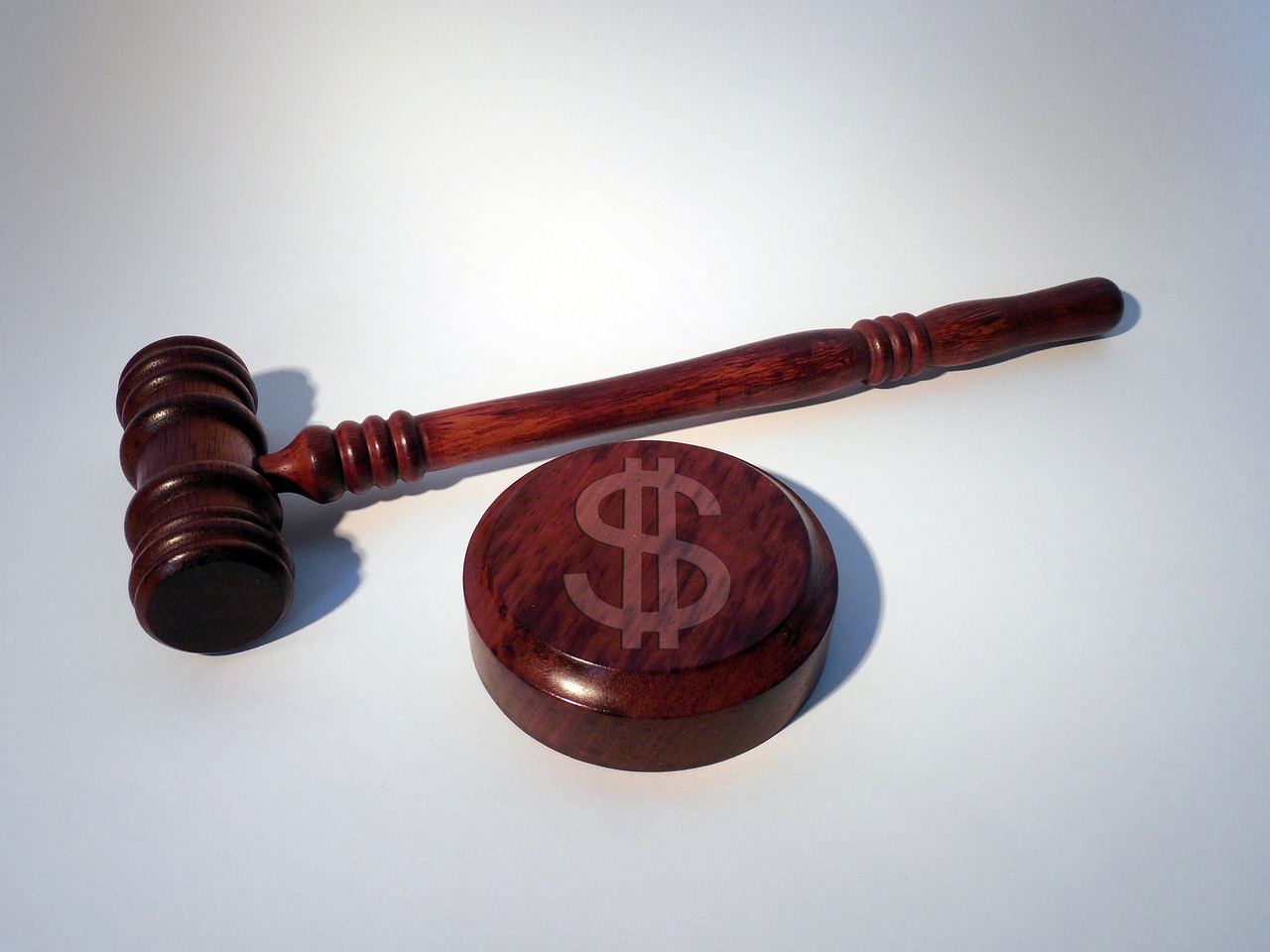
So now you have a Standard Residential Lease Agreement to use, you have instructions on how to fill it out, you have a decent understanding of every single section in the lease, and you have some resources to learn more about your state’s landlord-tenant laws. What to do next?
Well, it’s time for you to use your newfound lease knowledge to get your property rented and started generating some rental income! After all, that is why we do all this work as landlords, isn’t it?
A good lease that you understand how to use will not only allow you to make money by renting out your rental property, but it will protect you from the litany of things that can go wrong. Ever wonder why landlords have such great stories? Because so many things go wrong! So use your lease with confidence to protect you and help you financially.
Lastly, I want to thank you for reading my article, and I sincerely hope you learned something from it that will help you long term. Now go be a great landlord!
About the Author
Rich is an Entrepreneur, Landlord, and Lawyer licensed in the Great State of Texas. He enjoys family, community, and work. He started Landlord Guidance in 2012 to help fellow landlords, and teach them that being fair and ethical with their tenants is the true path to long-term success.
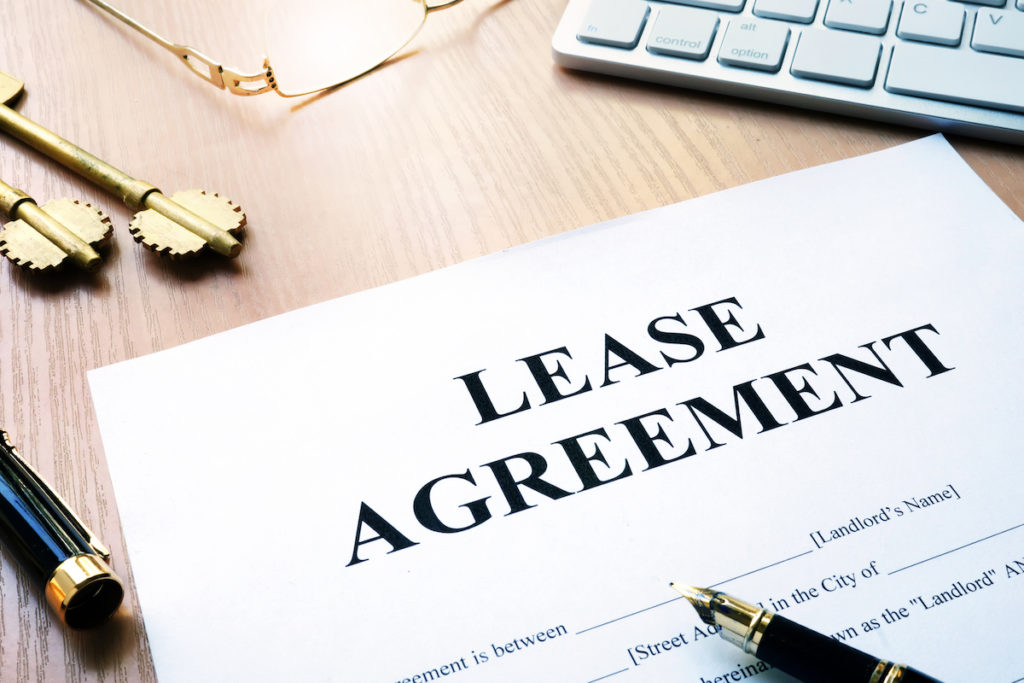

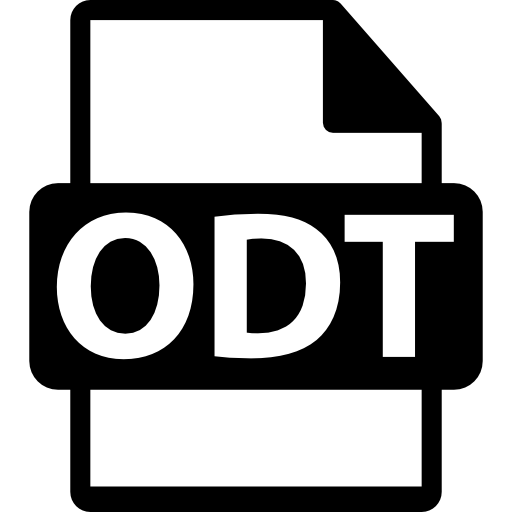
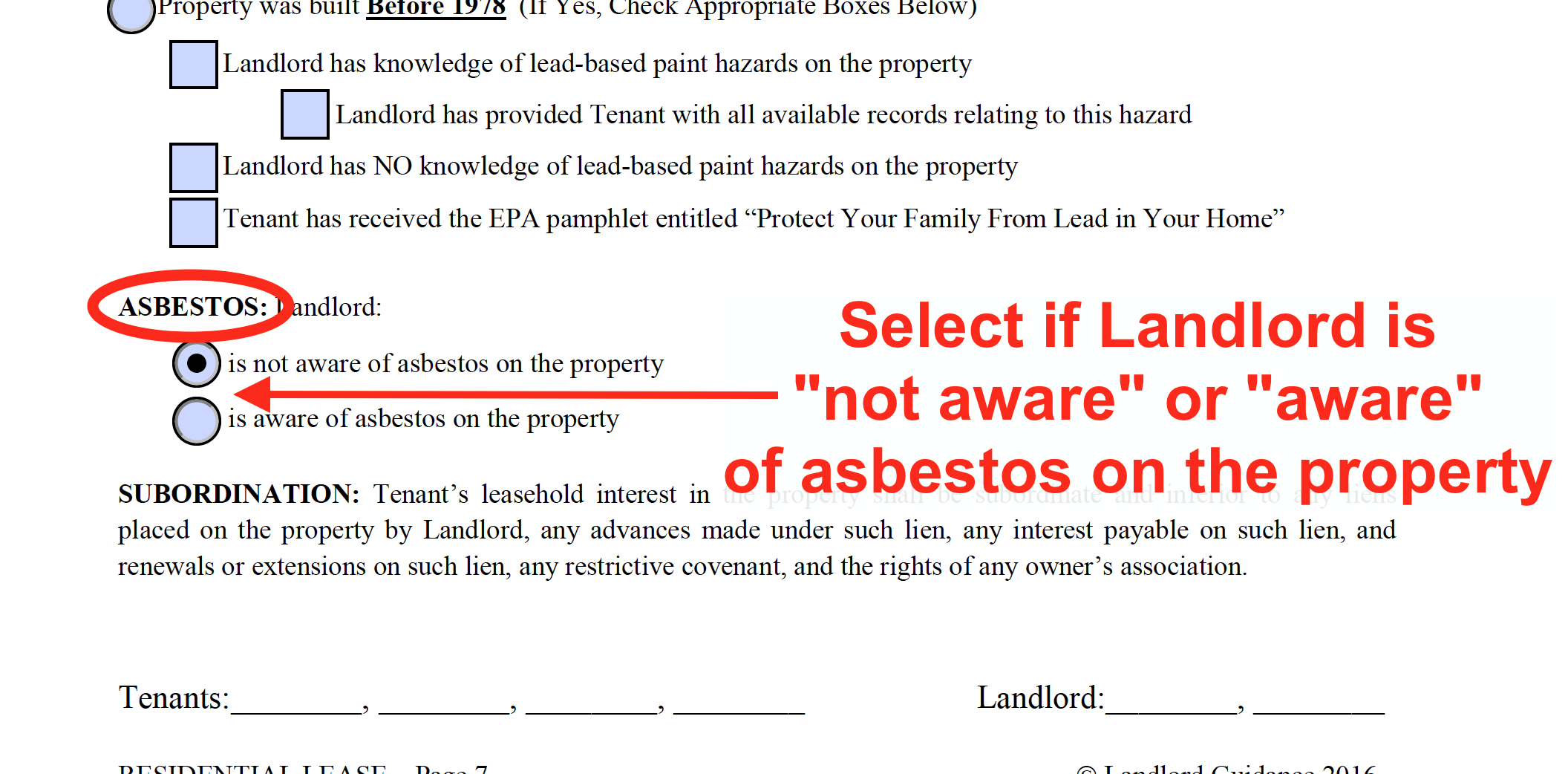
You must be logged in to post a comment.